Plan Projections
ideas to numbers .. simple financial projections
Home > Business Plan > Marketing Strategy in a Business Plan


Marketing Strategy in a Business Plan
… we will get this market share by …
- Product USP : Why buy our product? What characteristics does the product have to meet customer needs?
- Promotion : What marketing activities will be undertaken? What means of communication will the business use to persuade customers of the benefits of the product? Will it use above the line promotion or below the line promotion?
- Place : What are the distribution channels? How is the business going to reach customers with its product?
- Price : What price will the business charge for the product, and what goal is it pursuing with the pricing strategy? Will the business use premium, penetration, economy or skimming pricing strategies.
Marketing Strategy Presentation
The marketing strategy section of the business plan can be presented in four sections relating to each of the four P’s product, promotion, place, and price as shown in the example layout below.
The marketing strategy is a key section of the business plan, at this stage you are not trying to present a complete marketing plan, but simply trying to show the investor that each major section of the marketing strategy has been thought about and that you have a good marketing mix.
All of the four sections should be consistent with and support each other, for example, if you are planning to adopt a high price strategy, then the product would be aimed at an upmarket target customer, distributed at high end stores, and make use of one to one personal selling.
This is part of the financial projections and Contents of a Business Plan Guide , a series of posts on what each section of a simple business plan should include. The next post in this series sets out the business model which the business intends to use to generate revenue.
About the Author
Chartered accountant Michael Brown is the founder and CEO of Plan Projections. He has worked as an accountant and consultant for more than 25 years and has built financial models for all types of industries. He has been the CFO or controller of both small and medium sized companies and has run small businesses of his own. He has been a manager and an auditor with Deloitte, a big 4 accountancy firm, and holds a degree from Loughborough University.
You May Also Like
- Search Please fill out this field.
- Building Your Business
- Becoming an Owner
- Business Plans
How To Write a Marketing Strategy for Your Business Plan
Potential investors want to see how you plan to sell
:max_bytes(150000):strip_icc():format(webp)/alyssa-headshot-2018-5b73ee0046e0fb002531cb50.png)
How Marketing Strategy Fits Into Your Business Plan
The 4 ps: product, promotion, price, and place, 7 tips for writing a marketing strategy, the bottom line, frequently asked questions (faqs).
Bulent Ince / E+ Collection / Getty Images
A marketing strategy is important for all businesses because it clearly outlines how they'll find new customers and promote their products and services to ultimately achieve more sales. You can use the marketing strategy as a stand-alone tool, as part of a marketing plan, or as part of a business plan, all with slightly different components.
Let's focus on some marketing strategy examples for your business plan.
- A solid marketing strategy addresses the four Ps: product, promotion, price, and place.
- Your success can depend on understanding your clients’ needs and being flexible enough to find a way to meet them.
- Keep your budget in mind. You can only do what you can afford to do, and you should plan for accommodating periodic shortfalls.
The marketing strategy section of your business plan builds upon the market analysis section . The marketing strategy outlines where your business fits into the market and how you'll price, promote, and sell your product or service. It can also act as a source of important information for potential investors who are analyzing your business.
You can break down the key information in the marketing strategy section using the 4 Ps of marketing concept: product, promotion, price, and place.
Product can refer to either a physical product or a service that you plan on offering. Some of the product areas that fall into this section include:
- Related products or services
- Functionality
Promotion covers the various aspects of how you plan on marketing your product or service. The areas you should address include:
- Advertising
- Marketing budget
- Promotional strategy
- Publicity and public relations
- Sales force
- Sales promotion
This addresses the way you plan on pricing your product or service. The aspects of pricing you should address are:
- Bundling (if you have related products/services)
- Pricing flexibility
- Pricing strategy
- Retail price
- Seasonal price (if applicable)
- Wholesale (volume) price
Also known as distribution, this part is all about the delivery of your product or service to your customers. Some areas you should cover include:
- Distribution centers
- Distribution channels
- Inventory management
- Order processing
- Transportation
- Warehousing
Keep seven things in mind as you write the marketing strategy section of your business plan to make it as effective and relevant as possible.
Show How Unique You Are
The foundation of your marketing strategy should be your unique selling proposition (USP). This is the statement that outlines what differentiates you from everyone else in the market. Create your USP first, then build upon it by relating it to each of the 4 Ps.
The common thread through each part of your marketing strategy should be how your business solves a problem or meets a need better than anyone else.
Know Your Customers/Clients
The information you include in your marketing strategy should incorporate all the research you conducted in your market analysis . Make sure you have a clear idea of who your ideal customers or clients are, what they like, what they need, and what they expect. This will make your marketing strategy more accurate and applicable to your target audience.
Be Flexible
The 4 Ps of marketing work well for physical products, but you may have to tweak them a bit for services. For example, you might use your website instead of a physical location for the place section. Your website should also be a part of your promotion section, as should any social media platforms that you participate in.
Do Your Research
When you’re determining your pricing, you should have plenty of data to back up your decision when you're determining your pricing. Include industry reports, competitor ads, and comparisons that demonstrate the research you conducted and how you came to the conclusion that you're pricing your product or service correctly.
Use Visuals
As in other sections of your business plan, using charts, graphs, and images to illustrate your facts can make them easier for your audience to absorb and understand. Is your pricing right at the median of the industry? Are you planning to use a four-step distribution process?
Use visual aids to drive your point home.
Remember Your Budget
You'll outline the financial analysis of your company in another section of your business plan but keep those numbers in mind as you write your marketing strategy. Your marketing process may look good by itself, but you'll have a difficult time meeting your goals unless you tie it directly to your financial status.
Include Your Collateral
You should include samples as exhibits if you're going to talk about your marketing collateral in your marketing section. These might include brochures, fact sheets, videos, and photos.
Your marketing strategy is your overall plan for how you're going to make your business profitable. Larger enterprises might have different strategies for various arms of their operations. Sole proprietors carry the weight of a single plan on their own. But addressing all these components will increase your odds of success in any case.
What are the four types of marketing strategies?
Many consider the four Ps to be the basic types of marketing strategies, but others focus on four possible ways you can reach clients and consumers: search engine optimization, paid advertising, content marketing, and sales.
What are the seven Cs of marketing?
The seven Cs organize your marketing strategy. They can vary depending on who you talk to and the nature of your business, but you can tailor yours to best meet your goals and needs. Most include customer, consistency, creativity, and communication. Some include other factors, such as convenience, competition, credibility, culture, and change.
American Marketing Association. " The Four Ps of Marketing ."
Notes Learning. " 7 Cs of Marketing ."
OBC. " The 7 Cs of Marketing: How to Apply Them ."
Related Articles
What is a Marketing Plan & How to Write One [+ Examples]

FREE MARKETING PLAN TEMPLATE
Plug-and-play template to designed to guide your marketing plan development.

Updated: 08/07/24
Published: 06/12/18
Updated: August 07, 2024
Published: June 12, 2018
One of my favorite ways to break through writer’s block, whether the assignment is a marketing plan or a short story, is simply reading more examples. (I also recommend taking a long walk; you’d be surprised.)
![market strategy in business plan Download Now: Free Marketing Plan Template [Get Your Copy]](https://no-cache.hubspot.com/cta/default/53/aacfe6c7-71e6-4f49-979f-76099062afa0.png)
I can’t take you on a walk, but I can give you some examples, some inspiration, and some guidelines to get your creativity humming.
If you don’t know where to start, we’ve curated lists of marketing plans and marketing strategies to help you write a concrete plan that will produce results.
Let’s start by understanding the differences between the two.
Featured Resource: Free Marketing Plan Template

Looking to develop a marketing plan for your business? Click here to download HubSpot's free Marketing Plan Template to get started .
Table of Contents
Marketing Strategy Examples
What is a marketing plan, marketing plan vs. business plan, how to write a marketing plan, types of marketing plans, marketing plan examples, marketing plan faqs, sample marketing plan.
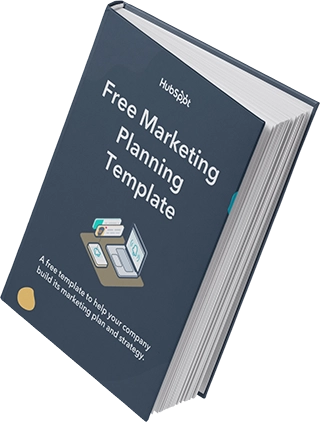
Free Marketing Plan Template
Outline your company's marketing strategy in one simple, coherent plan.
- Pre-Sectioned Template
- Completely Customizable
- Example Prompts
- Professionally Designed
Download Free
All fields are required.
You're all set!
Click this link to access this resource at any time.
A marketing plan is a strategic road map that businesses use to organize, execute, and track their marketing strategy over a given period. Marketing plans can include different marketing strategies for various marketing teams across the company, all working toward the same business goals.
The purpose of a marketing plan is to write down strategies in an organized manner. This will help keep you on track and measure the success of your campaigns.
Your marketing plan lays out each campaign‘s mission, buyer personas, budget, tactics, and deliverables. With all this information in one place, you’ll have an easier time staying on track with a campaign, and you can figure out what works and what doesn’t.
To learn more about creating your marketing plan, keep reading or jump to the relevant section:

A marketing plan is a strategic document that outlines marketing objectives, strategies, and tactics.
A business plan is also a strategic document. But this plan covers all aspects of a company's operations, including finance, operations, and more. It can also help your business decide how to distribute resources and make decisions as your business grows.
A marketing plan is a subset of a business plan; it shows how marketing strategies and objectives can support overall business goals. And if you need an assist executing a marketing plan, might I recommend HubSpot’s marketing hub ?
Marketing Strategy vs. Marketing Plan
A marketing strategy is the part of your marketing plan that describes how a business will accomplish a particular goal or mission.
This includes which campaigns, content, channels, and marketing software you’ll use to execute that mission and track its success.
A marketing plan contains one or more marketing strategies. It's the framework from which all your marketing strategies are created, and it helps you connect each strategy to a larger marketing operation and business goal.
For example, suppose your company is launching a new software product, and it wants customers to sign up. The marketing department needs to develop a marketing plan that'll help introduce this product to the industry and drive the desired sign-ups.
The department decides to launch a topical blog, debut a YouTube series to establish expertise, and create new X and Instagram accounts to join the conversation around this subject. All this serves to attract an audience and convert this audience into software users.
To summarize, a business' marketing plan is dedicated to introducing a new software product to the marketplace and driving sign-ups for that product. The business will execute that plan with three marketing strategies : a new industry blog, a YouTube video series, and an X account.
Of course, the business might consider these three things as one giant marketing strategy, each with its own specific content strategies. How granular you want your marketing plan to get is up to you. Nonetheless, every marketing plan goes through a particular set of steps in its creation.
- State your business' mission.
- Determine the KPIs for this mission.
- Identify your buyer personas.
- Describe your content initiatives and strategies.
- Clearly define your plan's omissions.
- Define your marketing budget.
- Identify your competition.
- Outline your plan's contributors and their responsibilities.
1. State your business' mission.
Your first step in writing a marketing plan is to state your mission. Although this mission is specific to your marketing department, it should serve as your business' main mission statement.
In my experience, you want to be specific, but not too specific. You have plenty of space left in this marketing plan to elaborate on how you'll acquire new customers and accomplish this mission.
For those of you running startups or small businesses, HubSpot’s starter bundle is a great all-in-one solution — it can help you find and win customers, execute content marketing plans, and more.
If your business' mission is “to make booking travel a delightful experience,” your marketing mission might be “to attract an audience of travelers, educate them on the tourism industry, and convert them into users of our bookings platform.”
Need help building your mission statement? Download this guide for examples and templates and write the ideal mission statement.
2. Determine the KPIs for this mission.
Every good marketing plan describes how the department will track its mission‘s progress. To do so, you need to decide on your key performance indicators (KPIs) .
KPIs are individual metrics that measure the various elements of a marketing campaign. These units help you establish short-term goals within your mission and communicate your progress to business leaders.
Let's take our example of a marketing mission from the above step. If part of our mission is “to attract an audience of travelers,” we might track website visits using organic page views. In this case, “organic page views” is one KPI, and we can see our number of page views grow over time.
Also, make sure to check whether your current reporting software facilitates the KPIs you need. Some reporting tools can only measure a set of pre-defined metrics, which can cause massive headaches in particular marketing campaigns.
However, other tools, like HubSpot’s analytics software , can offer full flexibility over the KPIs you wish to track.
You can generate custom reports that reveal average website engagement rates, page visits, email, social media traffic, and more.
These KPIs will come into the conversation again in step 4.
3. Identify your buyer personas.
A buyer persona is a description of who you want to attract. This can include age, sex, location, family size, and job title.
Each buyer persona should directly reflect your business' current and potential customers. All business leaders must agree on your buyer personas.
4. Describe your content initiatives and strategies.
Here‘s where you’ll include the main points of your marketing and content strategy.
Because there‘s a laundry list of content types and channels available today, you must choose wisely and explain how you’ll use your content and channels in this section of your marketing plan.
When I write this section, I like to stipulate:
- What types of content I'll create. These might include blog posts, YouTube videos, infographics, and ebooks.
- How much I'll create. I typically describe content volume in daily, weekly, monthly, or even quarterly intervals. It all depends on my workflow and the short-term goals for my content.
- The goals (and KPIs) I'll use to track each type. KPIs can include organic traffic, social media traffic, email traffic, and referral traffic. Your goals should also include which pages you want to drive that traffic to, such as product pages, blog pages, or landing pages.
- The channels on which I'll distribute my content. Popular channels include Facebook, X, LinkedIn, YouTube, Pinterest, and Instagram.
- Any paid advertising that will take place on these channels.
5. Clearly define your plan's omissions.
A marketing plan explains the marketing team's focus. It also explains what the marketing team will not focus on.
If there are other aspects of your business that you aren‘t serving in this particular plan, include them in this section. These omissions help to justify your mission, buyer personas, KPIs, and content.
You can’t please everyone in a single marketing campaign, and if your team isn’t on the hook for something, you need to make it known.
In my experience, this section is particularly important for stakeholders to help them understand why certain decisions were made.
6. Define your marketing budget.
Whether it's freelance fees, sponsorships, or a new full-time marketing hire, use these costs to develop a marketing budget and outline each expense in this section of your marketing plan.
You can establish your marketing budget with these 8 free marketing budget templates .
7. Identify your competition.
Part of marketing is knowing your competition. Research the key players in your industry and consider profiling each one.
Keep in mind that not every competitor will pose the same challenges to your business. For example, while one competitor might rank highly on search engines for keywords that you’re also chasing, another competitor might have a heavy footprint on a social network where you plan to launch an account.
Easily track and analyze your competitors with this collection of 10 free competitive analysis templates .
8. Outline your plan's contributors and their responsibilities.
With your marketing plan fully fleshed out, it‘s time to explain who’s doing what.
I don’t like to delve too deeply into my employees’ day-to-day projects, but I know which teams and team leaders are in charge of specific content types, channels, KPIs, and more.
Now that you know why you need to build an effective marketing plan, it’s time to get to work.
Starting a plan from scratch can be overwhelming if you haven't done it before.
That’s why there are many helpful resources that can support your first steps. We’ll share some of the best guides and templates to help you build effective results-driven plans for your marketing strategies.
The kind of marketing plan you create will depend on your company, your industry, and your business goals. We compiled different samples to suit your needs:
1. Quarterly or Annual Marketing Plans

This marketing plan by Visit Oxnard, a convention and visitors bureau, is packed with information: target markets, key performance indicators, selling points, personas, marketing tactics by channel, and much more.
It also articulates the organization’s strategic plans for the upcoming fiscal year, especially as it grapples with the aftereffects of the pandemic.
Lastly, it has impeccable visual appeal, with color-coded sections and strong branding elements.
- It states clear and actionable goals for the coming year.
- It includes data and other research that shows how the team made its decisions.
- It outlines how the team will measure the plan’s success.
4. Safe Haven Family Shelter

This marketing plan by a nonprofit organization is an excellent example to follow if your plan will be presented to internal stakeholders at all levels of your organization.
It includes SMART marketing goals , deadlines, action steps, long-term objectives, target audiences, core marketing messages , and metrics.
The plan is detailed yet scannable. By the end of it, one can walk away with a strong understanding of the organization’s strategic direction for its upcoming marketing efforts.
- It confirms ongoing marketing strategies and objectives while introducing new initiatives.
- It uses colors, fonts, and formatting to emphasize key parts.
- It closes with long-term goals, key themes, and other overarching topics to set the stage for the future.
5. Wright County Economic Development

- “Going viral” isn’t a goal; it’s an outcome.
- Be surprising. Subvert expectations.
- Be weird and niche if you want to be weird and niche, but establishing a shared cultural understanding might result in a bigger audience.
Pridemore Properties’ Instagram smash hit is unexpected, to say the least. You think you’re getting a home tour that takes your figurative breath away; you get a home tour that takes the agent’s literal breath away.

Verizon’s toe-tapping, hip-shaking Totalmente (aka Total by Verizon, a contractless phone plan) ad debuted during Univision’s Spanish-language broadcast of Super Bowl LVIII. The ad reinvents the 1998 Elvis Crespo song “Suavemente,” an earworm if I’ve ever heard one, replacing the lyrics with Total by Verizon features.
Verizon Value’s CMO and VP of Marketing, Cheryl Gresham, has admitted that she didn’t know much about marketing to a majority-Latinx audience.
In an interview with Campaign Live , she said she didn’t think the idea would have gotten off the ground “if it had just been me and a lot of other people that had a background like myself in that room.”
CampaignLive wrote, “Gresham says the team opted for a creative concept that spoke to all the Latinos in the room — despite Gresham herself not understanding the connection.”
Gresham’s marketing strategy hinged on knowing her audience and, just as importantly, trusting her fellow marketers who knew how to reach that audience.
Strategic Takeaways for Demographic Marketing
- Know what you don’t know.
- Foster diversity in marketing leadership and staff.
- Know your audience.
The catchy tune and the great storytelling certainly don’t hurt.
But more than that, Ogilvy and Verizon dug deep into Latinx culture — more than 25 years deep — to craft an ad that doesn’t feel like it’s just responding to the latest trend. They also tapped Venezuelan American comedian, musician, and producer Fred Armisen to direct the spot.
6. Chappell Roan

Implementing AI in Your Marketing Tech Stack — Expert Tips and Tricks You Need to Know

9 Business Challenges Every Small Business Struggles With (And How to Fix Them)
![market strategy in business plan How B2C Companies Leverage AI Marketing [Examples & Tips]](https://knowledge.hubspot.com/hubfs/ai-for-b2c-marketing-1-20241201-5752986.webp)

How B2C Companies Leverage AI Marketing [Examples & Tips]

Implementing AI in Your Marketing Tech Stack — Tips and Tricks You Need to Know
![market strategy in business plan How Internal Marketing Helps You Build a Strong Brand From the Inside Out [Experts Weigh In]](https://www.hubspot.com/hubfs/internal-marketing-1-20241126-7031360.webp)
How Internal Marketing Helps You Build a Strong Brand From the Inside Out [Experts Weigh In]
![market strategy in business plan The Top Goals of Marketing Managers & Leaders in 2025 [New Data + Expert Tips]](https://www.hubspot.com/hubfs/marketing-career-goals.webp)
The Top Goals of Marketing Managers & Leaders in 2025 [New Data + Expert Tips]

Holiday Marketing: 27 Steps, Tips, & Examples to Get Your Brand in the Spirit
![market strategy in business plan AI Target Audience: What I Learned [+ Tools to Try]](https://www.hubspot.com/hubfs/Untitled%20design%20-%202024-11-12T143944.345.png)
AI Target Audience: What I Learned [+ Tools to Try]
![market strategy in business plan Holistic Marketing Works — Here's How You Can Apply It to Your Campaigns [+ Expert Tips]](https://knowledge.hubspot.com/hubfs/holistic-marketing-1-20241114-5175552.webp)
Holistic Marketing Works — Here's How You Can Apply It to Your Campaigns [+ Expert Tips]

What's Below the Line Marketing Anyway? I Dove Deep Into BTL Marketing to Find Out
The weekly email to help take your career to the next level. No fluff, only first-hand expert advice & useful marketing trends.
Must enter a valid email
We're committed to your privacy. HubSpot uses the information you provide to us to contact you about our relevant content, products, and services. You may unsubscribe from these communications at any time. For more information, check out our privacy policy .
This form is protected by reCAPTCHA and the Google Privacy Policy and Terms of Service apply.
You've been subscribed
- For Individuals
- For Businesses
- For Universities
- For Governments
- Online Degrees
- Join for Free
Marketing Strategy: What It Is and How to Create One
A marketing strategy can set your business up for success. Learn why and how to make one for your business.
![market strategy in business plan [Featured image] A women stands in front of a digital whiteboard and leads a marketing strategy meeting with several coworkers.](https://d3njjcbhbojbot.cloudfront.net/api/utilities/v1/imageproxy/https://images.ctfassets.net/wp1lcwdav1p1/2bS9Rd8vBFkIcnziIbAqSY/426ec3a30c1f8dfe120bb9dd8a3c324d/GettyImages-1227481145.jpg?w=1500&h=680&q=60&fit=fill&f=faces&fm=jpg&fl=progressive&auto=format%2Ccompress&dpr=1&w=1000)
A marketing strategy is a long-term vision outlining a business’s value proposition to its customers. Rather than describing the concrete actions required in specific advertising campaigns, marketing strategies are a compass used to guide marketing efforts.
While it may be tempting to hash out a marketing plan right away, thinking about the marketing strategy first can improve your product's success and give you a competitive advantage. Learn what marketing strategy is, why it matters, different types, and steps to create your own.
If you're ready to start building skills to create effective marketing strategies, consider enrolling in the University of Illinois's Developing a Winning Marketing Strategy course .
What is a marketing strategy?
A marketing strategy is an overview of how a business or organization will articulate its value proposition to its customers. Generally, a marketing strategy outlines business goals, target market , buyer personas, competitors, and value for customers. It provides a long-term vision for overall marketing efforts, often looking many years ahead.
Advantages of a marketing strategy
Marketing strategies can have a measurable impact on success.
In 2022, CoSchedule surveyed 3,599 marketers and bloggers to identify their most successful marketing practices. They found that marketers who documented their marketing strategy were 331 percent more likely to report success than those who didn’t. Furthermore, marketers who were the most organized were found to be a whopping 674 percent more likely to report success [ 1 ].
Taking the time to create a marketing strategy can benefit your company's brand and bottom line. Watch this video to learn more about how to develop a winning marketing strategy:
Marketing strategy vs. marketing plan
People often use the terms “marketing strategy” and “marketing plan” interchangeably, but in reality, they are two different processes.
A marketing plan describes the concrete actions and marketing tactics undertaken to complete a marketing campaign. Meanwhile, a marketing strategy outlines the big picture of a marketing effort, such as the business's target customers. The strategy describes what the marketing objectives are, while the plan describes how those objectives are going to be achieved.
For example, imagine an e-commerce business that is trying to grow its customer base. They start a referral program to encourage word of mouth but it has little success. If they had created a strategy, they might have realized they needed to tap into new potential customers instead. A digital marketing strategy focused on targeted blog posts and search engine optimization (SEO) would have yielded better results.
Interested in digital marketing? Check out Google Digital Marketing & E-commerce Professional Certificate to gain valuable skills to kickstart a digital marketing career:
Types of marketing strategy
There are many different approaches to marketing – such as social media marketing or content marketing – but strategies for market growth can be found in Ansoff’s matrix . These four strategies are:
Market penetration
Product development
Market development
Diversification
H. Igor Ansoff is a mathematician and business manager who created the matrix to help businesses define their strategies by varying what product is being sold and who the product is being sold to [ 2 ].
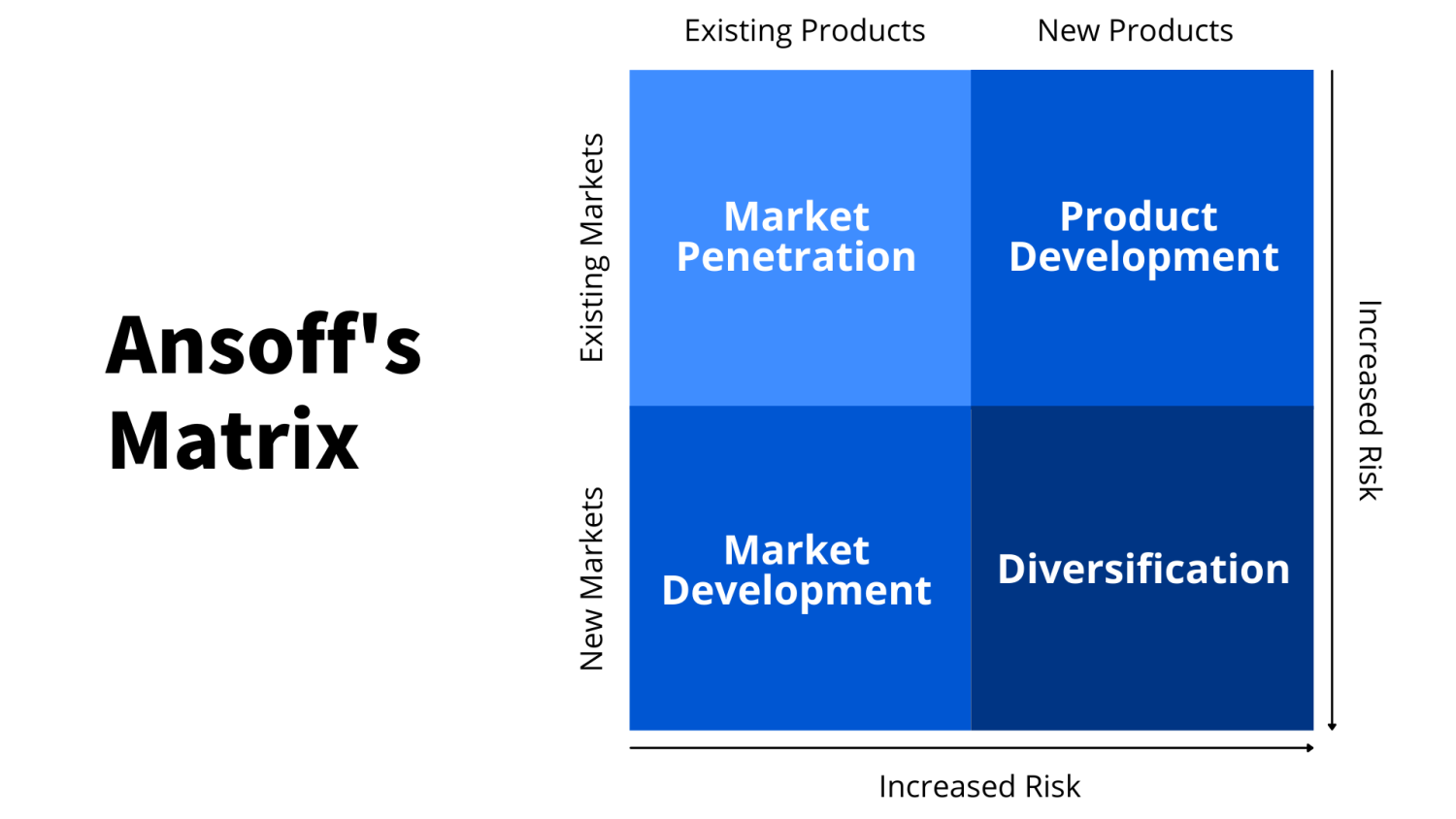
Ansoff’s matrix encourages markets to consider the four Ps , or the “marketing mix":
Product: What is being sold
Place: Where it is being sold
Price: What the product costs
Promotion: How the product is marketed to the target audience
The exact way that a marketer defines the four Ps for their marketing efforts will depend on the growth strategy they are using and the political and economic outlook of their market.
Let’s take a closer look at each strategy from Ansoff’s matrix.
Market penetration strategy
Market penetration strategy is a growth strategy that involves selling existing products to existing markets. It is considered the least risky of all the strategies in Ansoff’s matrix. The strategy is typically considered most beneficial if the market is either growing or the marketer alters its promotional efforts through existing marketing channels [ 2 ].
McDonald's "I'm Lovin' It" campaign
An example of a market penetration strategy can be found in McDonald’s “I’m Lovin’ It” campaign from 2003.
In the early 2000s, McDonald's faced flagging sales and plummeting stock prices. Rather than creating a new product (product development strategy), McDonald's instead focused on attracting existing customers in an existing market with a catchy ad campaign. The result was their wildly successful “I’m Lovin’ it” campaign, which featured a catchy new jingle sung by Justin Timberlake [ 3 ].
“I’m Lovin It” has since become McDonald’s longest-running marketing campaign since its founding in 1940 [ 4 ].
Product development strategy
A product development strategy involves the development of a new product for an already existing market. Typically, it is considered riskier than a market penetration strategy because it requires the creation of a totally new product. In order to be successful, product development strategies typically require innovation and further research into the existing market, including the profiles and needs of the target audience [ 2 ].
Uni Kuru Toga's mechanical pencil for every day writing
An example of a successful (and surprisingly interesting) product development strategy can be seen in the Uni Kuru Toga mechanical pencil.
As odd as it may seem, in the mechanical pencil world the Uni Kuru Toga is something of a star. “[T]he Uni Kuru Toga is the best mechanical pencil for every day writing,” opined the New York Time’s Wirecutter in a 2018 article [ 5 ]. Wired, meanwhile, called it “the ultimate geek tool” [ 6 ].
What makes the pencil so unique? A specially designed internal gear mechanism that rotates the lead so it stays sharp as you write and diamond infused lead that doesn’t easily break under pressure. In effect, as a 2009 commercial for the pencil demonstrated, it was meant for people concerned with even handwriting and durable lead [ 7 ].
While the market for mechanical pencils was already well-established, the Uni Kuru Toga was able to find success through a product development strategy that offered consumers something new and useful.
Market development strategy
A market development strategy takes an existing product into new markets. Much like a product development strategy, a market development strategy is considered riskier than a market penetration strategy because it involves introducing a familiar product into an unfamiliar marketplace. While the product remains the same, the new place it is sold requires possibly new pricing and promotional efforts [ 2 ].
Microsoft's Hololens technology
An example of a market development strategy is when Microsoft introduced its Hololens technology to an additional 29 markets in Europe in November of 2017 [ 8 ]. The augmented reality headset provides a unique user experience that allows professionals to work in a “mixed reality” environment. To promote their efforts, Microsoft released a YouTube video showcasing the unique use cases of the product in the workplace, such as through interactive employee training programs in industrial environments [ 9 ].
Diversification strategy
A diversification strategy involves the development of a new product for a new market. The novelty required of a diversification strategy means that it is also the riskiest of the Ansoff matrix’s four strategies. Diversification strategies require full attention on all of the four Ps – product, price, place, and promotion—but the biggest risks can also lead to the biggest rewards [ 2 ].
Apple's first iPhone
An example of a diversification strategy is when Apple introduced the first iPhone on June 9, 2007 at the MacWorld Expo. At the time, Apple was new to the mobile phone market, but they innovated in the space by adding a music player and web browser to their new touchscreen phone [ 10 ].
“Today Apple is going to reinvent the phone,” CEO Steve Jobs declared before an audience of reporters [ 10 ]. Through much of the presentation, Jobs outlined the phone’s unique value proposition to customers.
It worked. As of June 2022, there were an estimated 1.8 billion active iPhone users [ 11 ].
How to create a marketing strategy
A marketing strategy can set you up for marketing success. As you are creating your own marketing strategy, consider the following steps to help guide your process.
1. Define your business and marketing goals.
The first step in creating an effective marketing strategy is to clarify your business objectives and marketing goals. What are you trying to achieve with your market growth strategy?
The answer to this question will inevitably depend on your particular place in the market and your own comfortability with different risk levels.
Some examples of business and marketing goals include:
Grow customer base
Increase sales
Increase brand awareness
Whatever your objectives, the purpose is simply to consider what you want to actually accomplish by expanding your marketing efforts. These goals will guide the development of your marketing strategy.
2. Conduct market research.
Strategic marketing requires a comprehensive understanding of the marketplace, its economic and political context, and your product or service's place within it.
As you are conducting market research, you'll want to consider these factors:
Competitors, particularly their value proposition and market share
Market size, including the realistic number of customers that would be interested in your products
Market gaps where you can provide value
Possible economic and political realities that could impact the market in the long-term
As you gain a better understanding of the market, you will also better understand how you fit into it and where you can grow in it.
Deepen your understanding of customers using the power of GenAI with the Microsoft Copilot for Marketing Specialization.
3. Create a customer profile.
The purpose of every marketing campaign is to connect with potential customers. Your marketing strategy needs to include a comprehensive profile of your target audience.
Consider your target audience in relation to the four P's. Think through the following:
Based on what you know about the market, who is your target audience? What are their key demographics?
What is your product’s value proposition to your customer? (Product)
How much is your target audience willing to pay for your product or service? (Price)
Where does your target audience shop? (Place)
What marketing tactics are most persuasive to your target audience? (Promotion)
As you research and consider these questions, your customer should come more clearly into view, so you can create a strategy with maximum impact.
4. Synthesize and strategize.
Finally, take the goals you have outlined, research you have conducted, and profiles you have created to construct a marketing strategy. The critical question you will want to answer is: how will you align with your target market to meet your overall objectives?
Your answer to this question will be your strategy.
Ultimately, your marketing strategy should cover the following:
Business and marketing objectives
Market overview, including key facts and figures
Competitor research
Customer profile
General statement of strategy highlighting the product’s value proposition to customers
You might consider whether a social media strategy makes sense for your product or service. If so, your strategy could include user-generated content. Go a step further to consider which social media channels fit best with your target audience.
The Meta Social Media Marketing Professional Certificate is a great program for exploring different social media platforms and thinking about which platform is the best one for reaching potential customers.
Your marketing strategy doesn’t need to be too long. In fact, a strong marketing strategy can be as short as one page. Remember, this is meant to act as long-term guide for directing specific marketing tactics, not an action plan of how a marketing campaign will be done.
Advance your marketing skills with Coursera
Whether you are a seasoned marketing pro or a budding entrepreneur, building skills in key areas can help you create and execute effective marketing strategies. Coursera offers several online programs from industry leaders:
Develop social media savvy with the Meta Social Media Marketing Professional Certificate .
Use data to make empowered marketing decisions with the Meta Marketing Analytics Professional Certificate .
Learn about the digital marketing landscape with the Google Digital Marketing and E-Commerce Professional Certificate .
Harness the power of GenAI to accelerate your customer learnings and develop more impactful marketing strategies with the Microsoft Copilot for Marketing Specialization .
Article sources
CoSchedule. “ The Marketing Management + Strategy Statistics You Need to Know in 2019 , https://coschedule.com/marketing-statistics.” Accessed March 28, 2024.
Oxford College of Marketing. “ Using the Ansoff Matrix to Develop Marketing Strategy , https://blog.oxfordcollegeofmarketing.com/2016/08/01/using-ansoff-matrix-develop-marketing-strategy/.” Accessed March 28, 2024.
The Take Out. “ TIL McDonald’s ‘I’m Lovin’ It’ jingle was born out of desperation , https://thetakeout.com/history-of-mcdonald-s-i-m-lovin-it-jingle-1846400888.” Accessed March 28, 2024.
Chicago Magazine. “ Five Things You Never Knew About ‘I’m Lovin’ It’ , https://www.chicagomag.com/Chicago-Magazine/November-2014/McDonalds-Im-Lovin-It-Campaign/.” Accessed March 28, 2024.
NYT Wirecutter. “ The Best Mechanical Pencils , https://www.nytimes.com/wirecutter/reviews/best-mechanical-pencils/.” Accessed March 28, 2024.
Wired. “ Kura Toga: The Ultimate Geek Tool , https://www.wired.com/2011/11/kuru-toga-the-ultimate-geek-tool/.” Accessed March 28, 2024.
YouTube (Uni Ball UK). “ Uni Kuru Togat from Mutsibishi Pencil Company , https://www.youtube.com/watch?v=80k7Jl1o8Lc&t=22s.” Accessed March 28, 2024.
Tech Crunch. “ Microsoft expands HoloLens headsets to 29 new markets, now up to 39 , https://techcrunch.com/2017/11/01/microsoft-expands-hololens-headsets-to-29-new-european-markets/.” Accessed March 28, 2024.
YouTube (Microsoft HoloLens). “ Microsoft HoloLens: Mixed Reality in the Modern Workspace , https://www.youtube.com/watch?v=EIJM9xNg9xs.” Accessed March 28, 2024.
Computer World. “ Update: Jobs touts iPhone, Apple TV , https://www.computerworld.com/article/2549128/update--jobs-touts-iphone---appletv-.html.” Accessed March 28, 2024.
Earthweb. “ How many people use iPhones in 2022? , https://earthweb.com/how-many-people-use-iphones/.” Accessed March 28, 2024.
Keep reading
Coursera staff.
Editorial Team
Coursera’s editorial team is comprised of highly experienced professional editors, writers, and fact...
This content has been made available for informational purposes only. Learners are advised to conduct additional research to ensure that courses and other credentials pursued meet their personal, professional, and financial goals.
🎧 Real entrepreneurs. Real stories.
Subscribe to The Hurdle podcast today!
How to Write a Sales and Marketing Plan

2 min. read
Updated January 3, 2024

You’ve addressed what you’re selling and why in the products and services section. You now have an understanding of the market and an ideal customer in mind thanks to your market analysis. Now, you need to explain how you will actually reach and sell to them.
The marketing and sales section of your business plan dives into how you’re going to accomplish your goals. You’ll be answering questions like:
- Based on your audience, how will you position your product or service in the current market?
- What marketing channels, messaging, and sales tactics will you implement?
- What’s your business model and how will your business operate day-to-day?
By the end of this section, you should have an outline of what growth looks like, what milestones you intend to hit, and how you’ll measure success. Basically, you’re backing up the opportunity you’ve identified with a solid go-to-market plan.
What to include in the sales and marketing section
The sections you should include act as a useful framework for exploring and defining your marketing and sales tactics.
Create a positioning statement
How does your business differ? What do you do that others don’t? If you’re unsure, work through a handful of strategic exercises to create a simple but convincing positioning statement.
Outline your marketing strategy
A marketing plan brings together strategic goals with tangible marketing activities designed to reach and engage your target market—ultimately convincing them to purchase your product.
Craft your sales plan
A good sales strategy provides actionable steps to reach your goals. Estimate how much you intend to sell and outline a process that anyone else in your business can execute.
Optional sales and marketing information to include
The basics of a marketing and sales plan are fairly straightforward. However, it’s also the perfect place to flesh out any details that you think will make your outreach efforts successful.
Create a unique value proposition
What makes your business unique? How does the solution you provide stand out? This is your chance to point to what you believe potential customers will find more valuable about your business over the competition.
Don't forget digital marketing
While we don’t recommend creating separate traditional and digital marketing plans, it may be wise to explore and address them separately within your plan.
Build your promotional plan
How will you convince your customers to buy your products or services? While actual ads and promotions may be months away, it’s best to think through and even mock up designs now.
Conduct a SWOT analysis
With this simple analysis, you’ll better understand your strengths and weaknesses, along with the opportunities and threats you should account for.
Brought to you by
Create a professional business plan
Using ai and step-by-step instructions.
Secure funding
Validate ideas
Build a strategy
Kody Wirth is a content writer and SEO specialist for Palo Alto Software—the creator's of Bplans and LivePlan. He has 3+ years experience covering small business topics and runs a part-time content writing service in his spare time.

Table of Contents
- What to include
- Optional information
Related Articles

24 Min. Read
The 10 AI Prompts You Need to Write a Business Plan

10 Min. Read
How to Write a Competitive Analysis for Your Business Plan

How to Set and Use Milestones in Your Business Plan

3 Min. Read
What to Include in Your Business Plan Appendix
The LivePlan Newsletter
Become a smarter, more strategic entrepreneur.
Your first monthly newsetter will be delivered soon..
Unsubscribe anytime. Privacy policy .

The quickest way to turn a business idea into a business plan
Fill-in-the-blanks and automatic financials make it easy.
No thanks, I prefer writing 40-page documents.

Discover the world’s #1 plan building software
- Search Search Please fill out this field.
What Is a Marketing Plan?
Understanding marketing plans, how to write a marketing plan, marketing plan vs. business plan.
- Marketing Plan FAQs
The Bottom Line
- Marketing Essentials
What Is a Marketing Plan? Types and How to Write One
:max_bytes(150000):strip_icc():format(webp)/photo__james_chen-5bfc26144cedfd0026c00af8.jpeg)
- How to Start a Business: A Comprehensive Guide and Essential Steps
- How to Do Market Research, Types, and Example
- Marketing Strategy: What It Is, How It Works, How To Create One
- Marketing in Business: Strategies and Types Explained
- What Is a Marketing Plan? Types and How to Write One CURRENT ARTICLE
- Business Development: Definition, Strategies, Steps & Skills
- Business Plan: What It Is, What's Included, and How to Write One
- Small Business Development Center (SBDC): Meaning, Types, Impact
- How to Write a Business Plan for a Loan
- Business Startup Costs: It’s in the Details
- Startup Capital Definition, Types, and Risks
- Bootstrapping Definition, Strategies, and Pros/Cons
- Crowdfunding: What It Is, How It Works, and Popular Websites
- Starting a Business with No Money: How to Begin
- A Comprehensive Guide to Establishing Business Credit
- Equity Financing: What It Is, How It Works, Pros and Cons
- Sole Proprietorship: What It Is, Pros & Cons, and Differences From an LLC
- Partnership: Definition, How It Works, Taxation, and Types
- What is an LLC? Limited Liability Company Structure and Benefits Defined
- Corporation: What It Is and How to Form One
- Starting a Small Business: Your Complete How-to Guide
- Starting an Online Business: A Step-by-Step Guide
- How to Start Your Own Bookkeeping Business: Essential Tips
- How to Start a Successful Dropshipping Business: A Comprehensive Guide
Investopedia / Zoe Hansen
A marketing plan is an operational document that outlines an advertising strategy that an organization will implement to generate leads and reach its target market . It details the outreach and PR campaigns to be undertaken and for how long, as well as the ways in which the company will measure the effect of these initiatives. It reflects a company’s overall marketing strategy.
Key Takeaways
- The marketing plan details the strategy that a company will use to market its products to customers.
- The plan identifies the target market, value proposition of the brand or product, campaigns to be initiated, and metrics to be used to assess the effectiveness of marketing initiatives.
- The marketing plan should be adjusted on an ongoing basis based on which efforts are having an impact and which are not.
- Digital marketing shows results almost in real time, whereas TV ads require rotation to realize any level of market penetration.
- A marketing plan is part of a business plan, which describes all of the important aspects of a business, such as its goals, values, mission statement, budget, and strategies.
The terms “marketing plan” and “marketing strategy” are often used interchangeably because the former is developed based on an overarching strategic framework. In some cases the strategy and the plan may be incorporated into one document, particularly for smaller companies that may only run one or two major campaigns in a year. The plan outlines marketing activities on a monthly, a quarterly, or an annual basis, while the strategy delineates the overall value proposition .
The components of a marketing plan include:
- Market research – This provides information to support pricing decisions and new market entries.
- Tailored messaging – This involves targeting certain demographics and geographic areas and can include the use of affiliate marketing with third-party publishers who bring customers to the table.
- Platform selection – This looks at the best vehicles for disseminating product information for each advertising campaign: traditional venues such as radio, TV, newspapers, and commercial and trade magazines; digital methods such as websites, online ads, search engine results, informational videos, social media groups (Facebook, YouTube, etc.), email, and text messages; or any mix of these platforms.
- Performance metrics – Metrics accurately assess the results of marketing efforts and their reporting timelines and are crucial to the success of the plan.
The four most important social media networks in 2023 for global marketers were, in descending order, Facebook, Instagram, YouTube, and TikTok.
Types of Marketing Plans
There are a variety of marketing plans that suit different businesses and their needs. These include:
- Product Launch – A product-launch marketing plan outlines how a new product will enter the market, the audience it will target, and the advertising methods used.
- Social Media – A social media marketing plan focuses on the advertising strategies on different social media platforms and how to engage with their users.
- Time Based – Time-based marketing plans, such as those that are executed quarterly or annually, focus on the time of the year, the current condition of the business, and the best strategies in that period.
- Content Based – A content-based marketing plan looks in detail at what kinds of content (blogs, videos, graphics, etc.) will reach the target audience.
- Search Engine Optimization (SEO) – An SEO marketing plan is all about getting the most hits online. It involves keyword research, content optimization, link building, and more, all with the goal of drawing customers to your website.
Mission and Value Proposition
The mission and value proposition is a statement that articulates the value that a product or brand will deliver to a customer. It should appear front and center on the company website and any branding materials.
The value proposition should delineate how a product or brand solves the customer’s problem, the benefits of the product or brand, and why the customer should buy from this company and not another. The marketing plan is based on it.
Set Key Performance Indicators (KPIs)
Establishing your key performance indicators (KPIs) will allow you to measure the success of your marketing plan in relation to your company’s value proposition. In other words, they track the effectiveness of your marketing strategy. For example, if your goal is to engage with a certain demographic in a certain region, you can track social media impressions and website visits.
There are a number of KPIs that help you measure success including the search engine ranking, click-through rate, cost per click, return on investment (ROI), and conversion rates, which tracks the percentages of visitors to your website that make a specific action such as buying a product or becoming a newsletter subscriber.
In 2023, Facebook and Instagram were tied for having the highest ROI across social media platforms for global marketers, while YouTube fell next in line.
Identify Your Target Market
The marketing plan identifies the target market for a product or brand. Market research is often the basis for a target market and marketing channel decisions. For example, whether the company will advertise via social media, online ads, or regional TV.
Knowing to whom you want to sell and why is an extremely critical component of any business plan. It allows you to focus your business and measure its success. Different demographics have different tastes and needs; knowing your target market will help you market to them.
Strategy and Execution
The marketing plan includes the rationale for these decisions. The plan should focus on the creation, timing, scheduling, and placement of specific campaigns and include the metrics that will measure the outcomes of your marketing efforts. For example, will you advertise on social media or TV? What time will you schedule your marketing if they are through email newsletters? The strategy may include flighting scheduling , which includes the times when you can make the most of your advertising dollars.
Set Your Budget
A marketing plan costs money. Setting a budget will allow you to create a workable plan, prevent runaway costs, and properly allocate your funds.
Adjust Your Plan
A marketing plan can be adjusted at any point based on the results from its metrics. If digital ads are performing better than expected, for example, the budget for a campaign can be adjusted to fund a higher-performing platform, or the company can initiate a new budget. The challenge for marketing leaders is to ensure that every platform has sufficient time to show results.
Without the correct metrics to assess the impact of outreach and marketing efforts, an organization will not know which campaigns to repeat and which to drop. In short, maintaining ineffective initiatives wastes money.
Digital marketing shows results almost immediately, whereas TV ads require rotation to realize any level of market penetration. In the traditional marketing mix model, a marketing plan would fall under the category of “promotion,” which is one of the “ four Ps ,” a term coined by Neil Borden to describe the marketing mix of product, price, promotion, and place.
A business plan is a roadmap that details how a business will operate and function in its entirety. It should cover the goals, missions , values, financials, and strategies that the business will use in day-to-day operations and the achievement of its objectives. Among its many elements are an executive summary, the products and services sold, a marketing analysis, a marketing strategy, financial planning, and a budget .
As mentioned, a business plan should include a marketing plan, which focuses on creating a strategy for creating awareness of the company’s product or service, reaching the target market, and generating sales.
Example of a Marketing Plan
Consider the following marketing plan framework that is designed to help direct marketing objectives:
- Executive Summary: Describes company mission, key executives, and where it is headquartered.
- SWOT Analysis: Describes strengths, weaknesses, opportunities, and threats for the company. This helps you define how to build on your strengths and how to find ways to improve on your weaknesses. It also helps a company analyze their competitors and how they may achieve an advantage based on their unique value proposition.
- Business Initiatives: Outlines the goals of the marketing plan, such as the number of impressions, Google rankings, or email subscribers.
- Customer Analysis: Describes your target market and audience characteristics based on market research. These may include age, pain points, and location, among other variables.
- Competitor Analysis: Outlines the companies providing similar goods or services to your target audience. In addition, it describes their strengths, market share, pricing structure, and most importantly where your company can fill an important gap.
What Is a Marketing Plan Template?
A marketing plan template is a guide for writing a marketing plan. It contains all the important elements needed to create one, including its goals and KPIs, marketing channels, budget, content type, teams involved, and design.
What Is an Executive Summary in a Marketing Plan?
The executive summary is a nutshell description of the marketing plan. It should contain the key findings of the market research, the company’s objectives and marketing goals, an overview of the marketing trends, the description of the product or service being marketed, information on the target market, and the plan budget.
What Is a Top-Down Marketing Strategy?
A top-down marketing strategy is a traditional one, in which a business decides how best to sell its product or brand, and customers are then spurred to take action through advertisements, generally found on radio and/or television. It is usually determined by company executives, which is then communicated with management to delegate to employees. These employees then develop tactics to meet the strategy's objectives.
What Is a Bottom-Up Marketing Strategy?
In comparison to a traditional top-down marketing strategy, a bottom-up strategy begins with employees who formulate marketing tactics based on their analysis of customer preferences and needs. This then may lead to collaboration with other employees to develop a concrete marketing plan, which is sent to executives for review.
Today’s consumer wants to relate to a product or service in a meaningful way, and a bottom-up marketing strategy seeks to achieve this through customer-centric tactics.
How Much Does a Marketing Plan Cost?
The cost of a marketing plan will vary based on the company, the plan’s complexity, and the length of the overall strategy. In 2023, marketing costs made up 10.1% of corporate revenues on average. The consumer packaged goods sector spent the most, at 18.5% of revenues while the mining and construction sector spent the least, at 1% of revenues.
A separate analysis shows that the cost can range anywhere from $10,000 to over $40,000 for a marketing plan.
A marketing plan is the advertising strategy that a business implements to sell its product or service. It determines the target market, how best to reach it, at what price point the product or service should be sold, and how the company will measure its efforts.
Constantly monitoring and adjusting a market plan is an important part of running a business, as it shows the most effective ways to generate sales. As the consumer landscape evolves, it is important for businesses to adapt in order to meet customer needs and better achieve their marketing objectives.
Statista. " Marketing Worldwide – Statistics and Facts ."
American Marketing Association. " What Is a Marketing Plan and How to Write One? [Easy Guide] ."
HubSpot. " The 2024 State of Marketing & Trends Report: Data from 1400+ Global Marketers ."
Deloitte. " The CMO Survey: Managing Marketing Technology, Growth and Sustainability ." Page 16.
Laire. " How Much Does a Marketing Plan Cost? "
:max_bytes(150000):strip_icc():format(webp)/GettyImages-1181747627-57684be4fc1c410c9c89e070673da094.jpg)
- Terms of Service
- Editorial Policy
- Privacy Policy
- Your Privacy Choices
Free Marketing Plan Examples: Real-World Samples & Templates
By Joe Weller | April 27, 2024
- Share on Facebook
- Share on LinkedIn
Link copied
A marketing plan is a comprehensive document that outlines a company’s marketing strategy and tactics, and ensures that its marketing goals align with its overall objectives. Effective marketing plans include detailed analysis of the market along with roadmaps for upcoming campaigns. Inside this article, you’ll find the elements of a marketing plan , 10 real-world examples of marketing plans with commentary from experienced marketing professionals, free marketing plan templates and samples , and a chart to help you determine which template suits your needs .
Marketing Plan Elements
Typical marketing plans begin with an executive summary and include audience demographics, company objectives, situational analysis of the business, and marketing strategies and tactics. Market research and analysis provide campaign direction, and the budget and timeline offer practical parameters. A marketing plan can provide an overview of all strategies and campaigns to be executed in a certain time frame, or it can focus on a specific product, channel, or strategy. The level of detail and the sections included might vary, depending on the organization’s needs. The nine main elements of a marketing plan are:
Executive Summary and Mission Statement: A concise, high-level summary conveys the purpose of your marketing plan, introduces key strategies and research insights, and highlights the most important takeaways for stakeholders. For example, an executive summary might outline your brand’s identity, its place within the competitive landscape, and the major opportunities that upcoming marketing campaigns will target. Longer plans might include a separate mission statement or vision statement to align marketing efforts with your company’s larger goals. Discover more examples of executive summaries with templates to help you write one effectively.
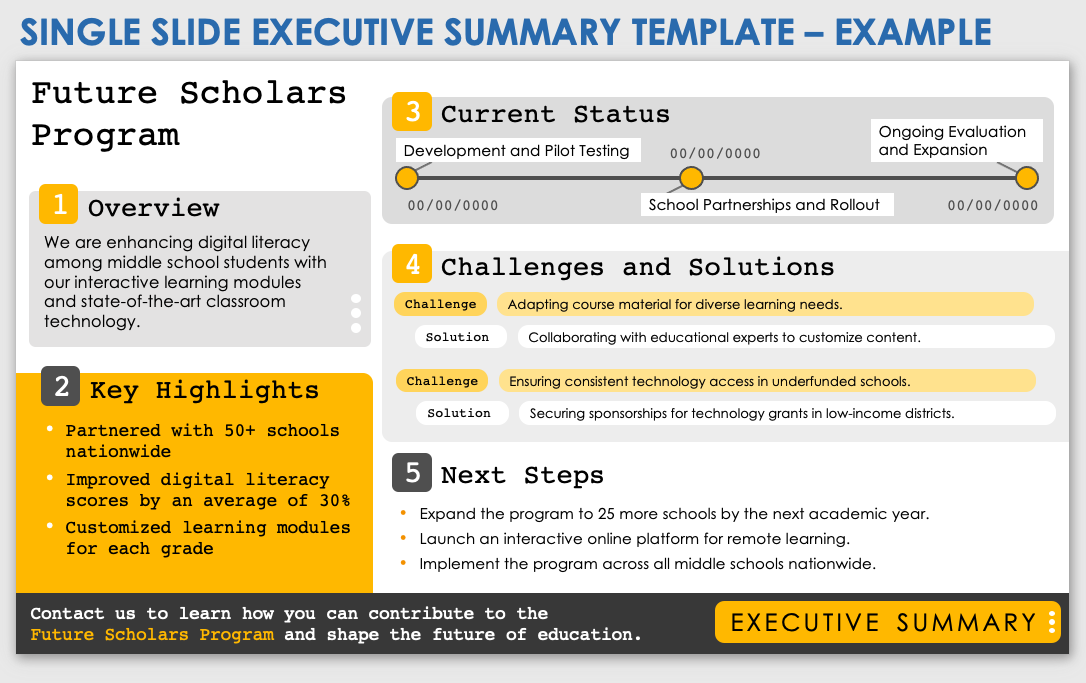
Situational Analysis: One of the most crucial elements of your marketing plan, a situational analysis is an assessment of the internal and external factors affecting a business’s performance. It should include research-based insights into market trends and dynamics, customer demographics and pain points, and internal resources. A strong situational analysis often includes a SWOT (strengths, weaknesses, opportunities, threats) analysis, which provides a foundation for an effective marketing strategy. Learn more about how to perform a SWOT analysis .
Competitive Analysis: Understanding the competition is key to developing a compelling marketing plan. This analysis should consider recent marketing campaigns from similar brands to identify successful ways to reach a shared target audience. Being aware of the competitive landscape can also help your business develop a unique selling proposition and stand out in the market. The competitive analysis might be included in the larger situational analysis, or it might be a stand-alone section. For example, a marketing plan could include data on how competitors rank on keywords, or it could evaluate the performance of competitors’ recent social media campaigns. One common framework for understanding market dynamics is a Porter’s five forces analysis, which identifies the forces that contribute to industry rivals. Learn how to evaluate the competitive landscape with free industry analysis templates .
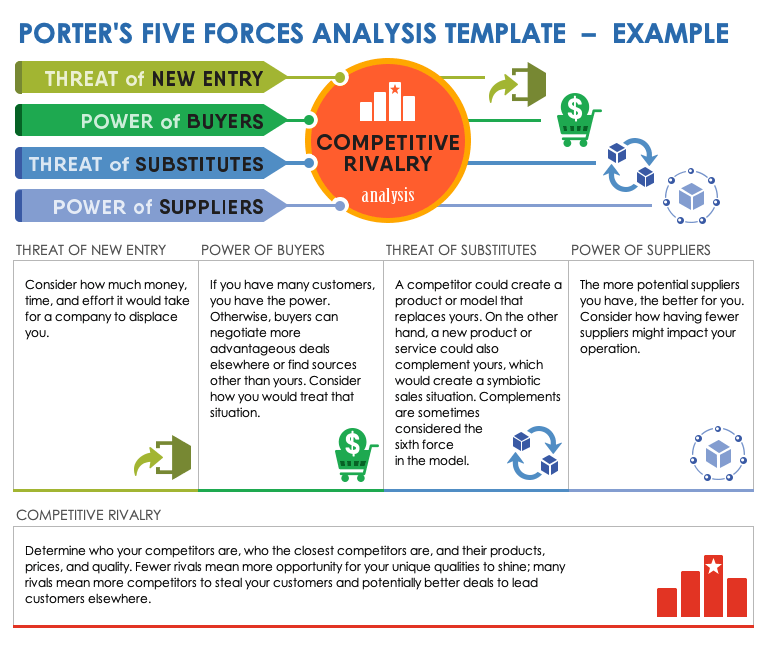
Target Audience: In order to implement marketing strategies that engage consumers and drive conversions, businesses need to know who their audience is, what they want, and how they behave. A marketing plan should define a specific, segmented target audience with demographic, geographical, psychographic, and behavioral data. This section often includes customer profiles or buyer personas — fictionalized representations of ideal customers or audience segments — which help marketers typify consumer behaviors. These profiles should include media habits and most-used platforms to ensure that your marketing plan selects the right channels for each campaign. Learn how to analyze your target market with free customer profile templates .
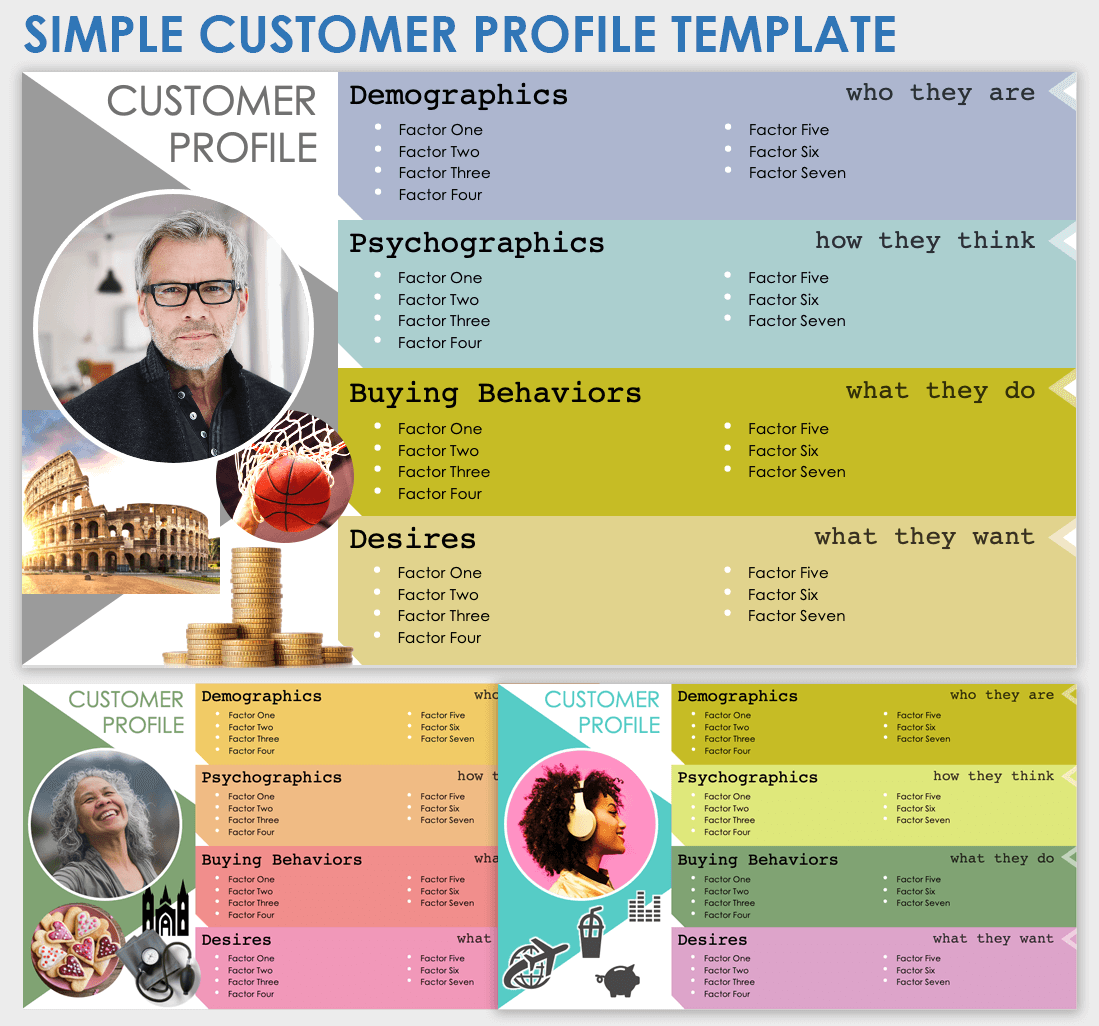
Goals and Objectives: Marketing plans typically include both long-term goals, which provide broad direction for the company’s marketing strategy, and short-term objectives, which focus on more immediate tactics and campaigns. Goals should be SMART (specific, measurable, achievable, relevant, time-bound) and include corresponding key performance indicators (KPIs). The goals and objectives in a marketing plan often focus on conversions, market share, brand awareness, or engagement. Clearly defined goals ensure strategically aligned marketing initiatives with measurable results. Take a look at real-world examples of SMART goals for more insights.
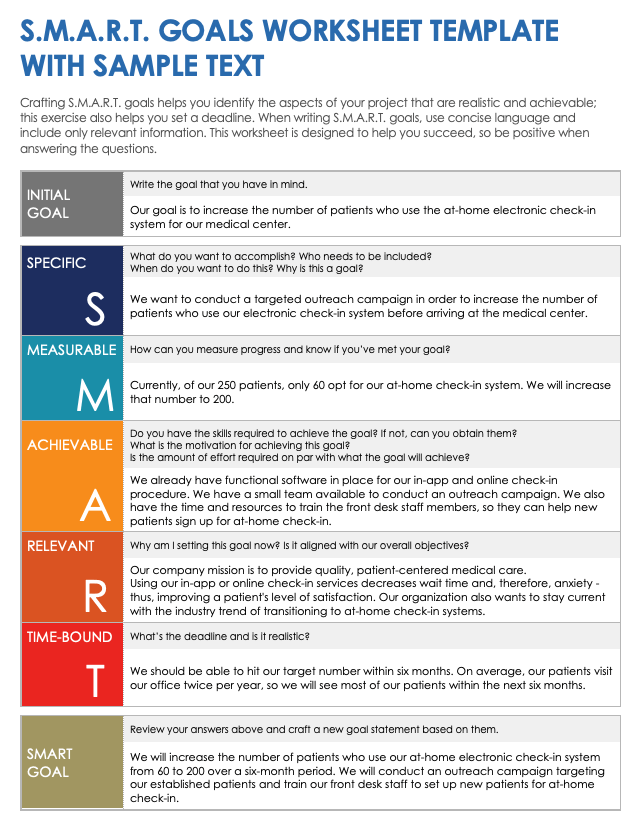
Marketing Strategy: This section of a marketing plan details the business’s unique value proposition and the channels that will communicate it. A robust marketing strategy addresses the touchpoints in a consumer’s buying cycle and breaks down the 4 Ps (product, price, place, promotion) of the marketing mix. Channels might include digital marketing, advertisements, social media, and influencer partnerships. To develop an overarching marketing strategy, consider using a marketing strategy template . To learn more about the 4 Ps, read this product marketing guide .
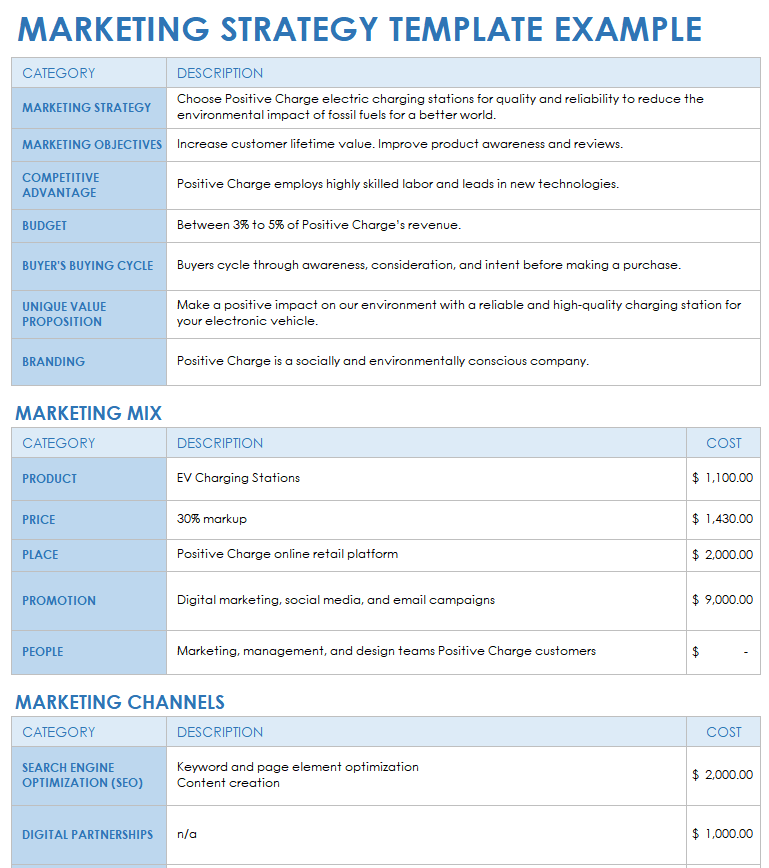
Tactics and Action Plan: A marketing plan is not an abstract strategy document, but a concrete roadmap for executing specific campaigns with specific tactics. Your plan should detail the messaging for each campaign and the corresponding methods for communication — such as email newsletters, social content, targeted ads, and public relations. This section provides KPIs and actionable steps such as resource allocation, deliverables, and distribution plans. It might also include the expected outcome for each campaign. To plan individual campaigns, consider using a marketing project plan template .
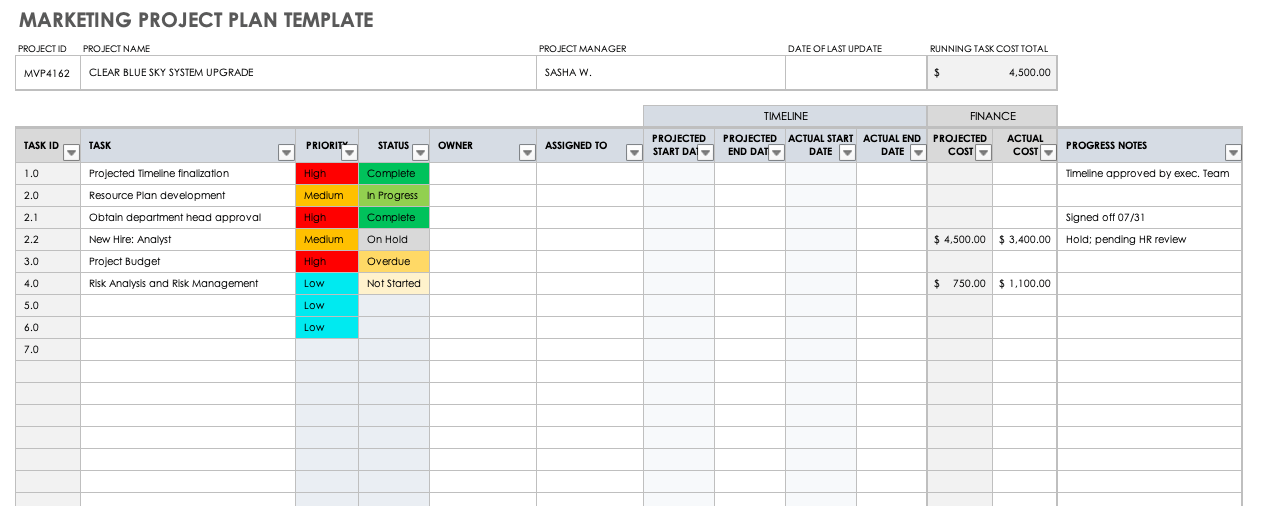
Budget: Marketing expenses might include the cost of advertising, content creation, website maintenance, or promotional materials; no marketing plan is complete without a budget that breaks down the costs of such initiatives. A clear, comprehensive budget ensures that marketing efforts are financially feasible and resources can be allocated for maximum impact. The budget also enables the marketing team to track the return on investment (ROI) of each campaign. To create a comprehensive budget, try our free marketing budget templates .
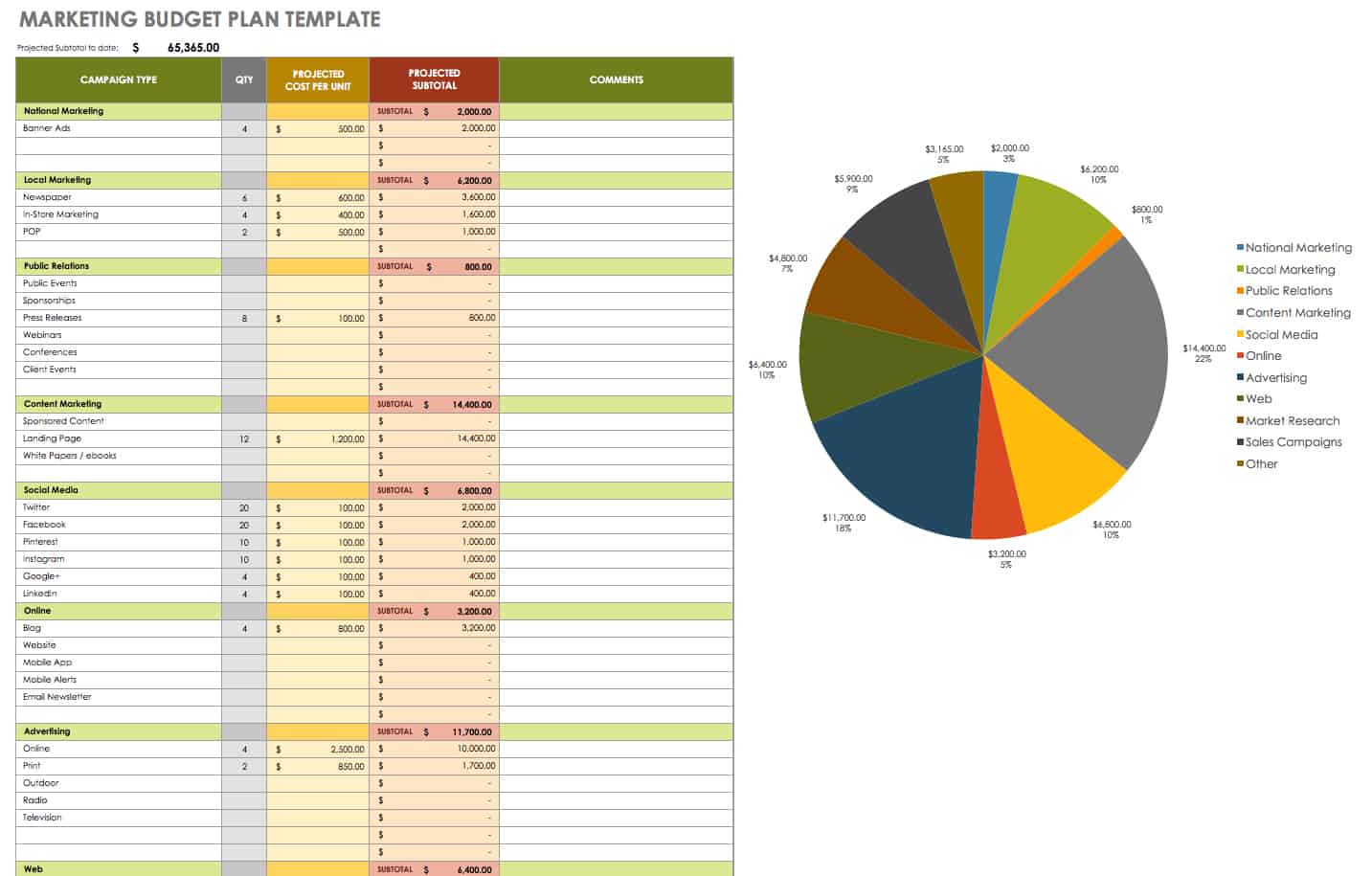
Timeline: Finally, a marketing plan includes a clear schedule for implementing its initiatives and tactics. This timeline details the start and end dates of each campaign, deadlines for deliverables, and key events or milestones. It keeps the marketing team aligned and initiatives on track, ensuring that marketing objectives can be achieved within the set time frame. Organize dates and deadlines with the help of a marketing timeline template .
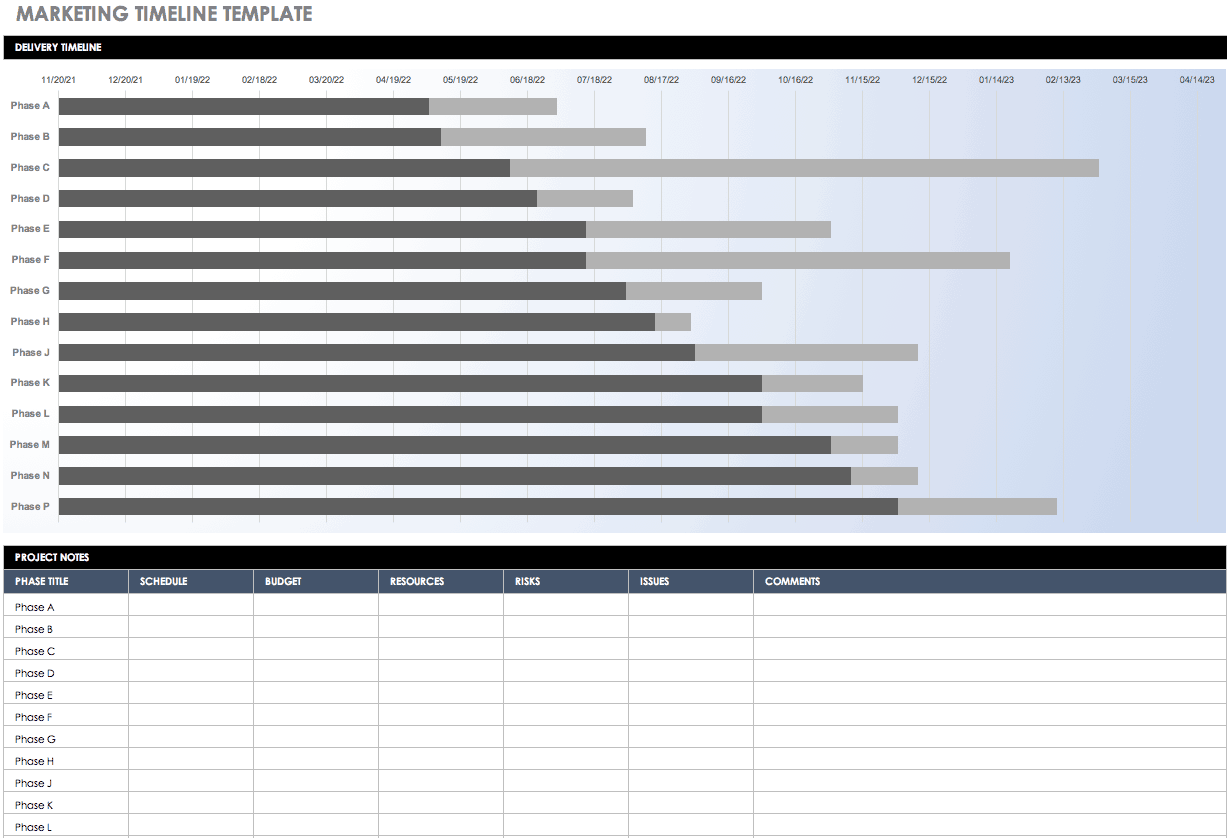
Marketing Plan Examples
Real-world marketing plans show how businesses utilize effective planning documents. These 10 examples from various industries exhibit unique strengths and weaknesses. With insightful commentary from marketing experts, these plans offer practical takeaways any marketer can use.
Delmarva and the Ground for Change This in-depth marketing plan for a documentary produced by the USDA Northeast Climate Hub includes audience profiles, competitive analysis, and a distribution plan. Along with a detailed breakdown of its digital marketing strategy, it considers how different tactics will affect the viewer’s content journey.
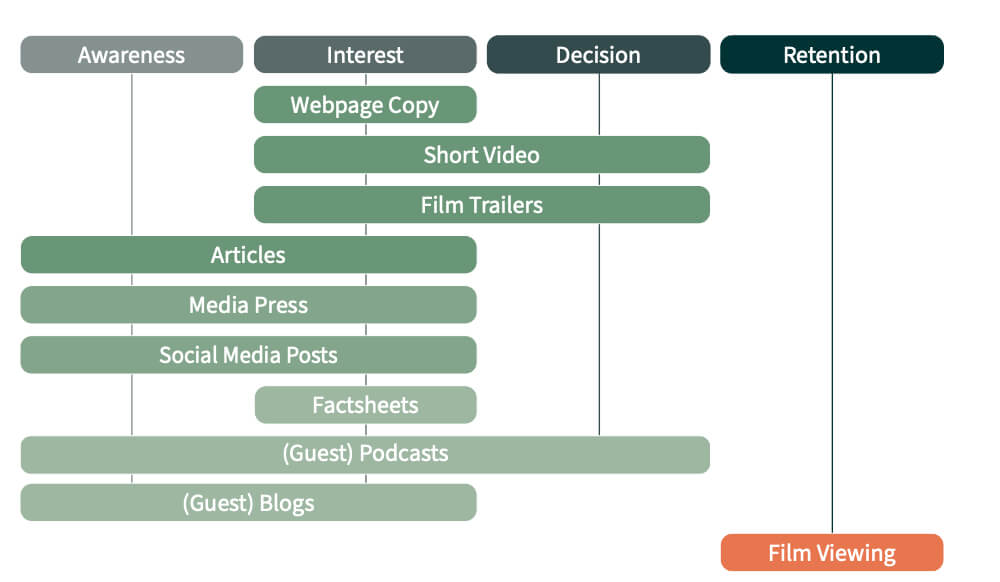
John Dinsmore , a marketing consultant and professor at Wright State University, praises this plan for its attractive design and thoughtful, thorough content: “They do a nice job of extrapolating on who the target market is and tying their tactics to achieving specific goals.” He appreciates the inclusion of a SWOT analysis, but feels it could be done more effectively. “‘Opportunities’ is not a place for business ideas. It’s a place to identify external, positive trends that can help your initiative. In this context, an opportunity could be ‘Rising concern for and awareness of climate issues.’ Similarly, ‘threats’ is not a place to list things that are difficult. It’s for negative external trends such as ‘Increased skepticism over ability to combat climate change.’”

Dekker Fraser , former Global Marketing Manager at Sony PlayStation, adds that this plan includes a strong focus on collaborations with media and influencers: “Many marketing plans place too much emphasis on target customers and not enough on target collaborators.”
Minnesota Tourism This marketing plan by Explore Minnesota , the state’s Department of Tourism, showcases Minnesota’s beauty with vivid imagery. It uses a variety of demographic information to identify priority audience segments and includes well-designed infographics that analyze audience and competition. As a result, the campaigns are clearly targeted at specific audiences and objectives.

John Rarrick , Head of Marketing at Movius Corp., admires the strength of the message behind the strategy. “This plan has a very well-developed ‘why,’” he says. “You’ll see that often when the plan is to repair or save something that has undergone a time of great loss — such as a loss of revenue or reputation. The audience personas, goals, tactics, and budget are all detailed and measurable.”

Gold Coast Transit District
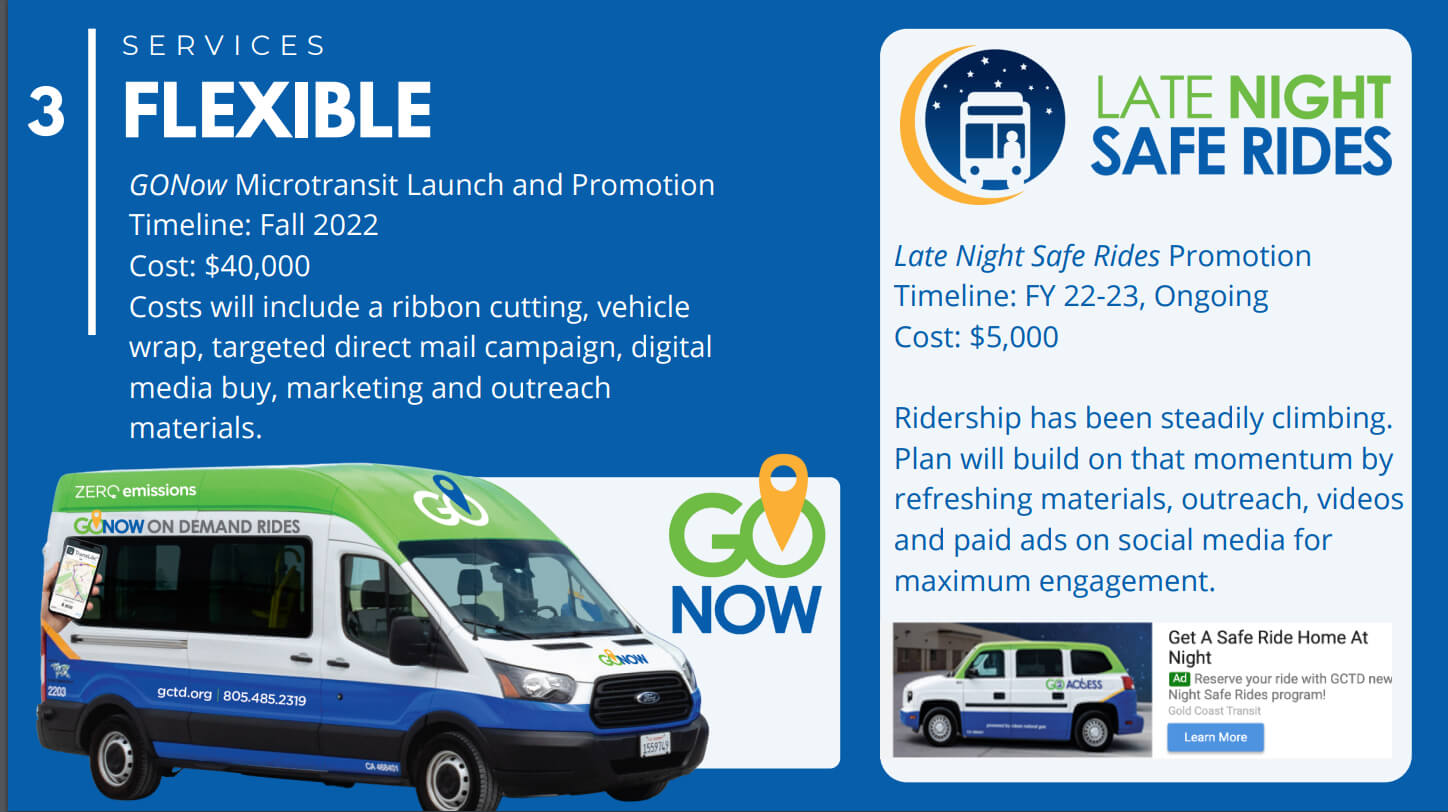
A short, high-level marketing plan for Gold Coast Transit highlights key campaigns and includes the most important details, such as timelines, budgets, and tactics. It begins with a bulleted overview of the most important takeaways and takes into account general marketing efforts that don’t fit under a specific campaign umbrella. Fraser notes that this plan includes year-round marketing initiatives, with an effective “emphasis on strong offers, such as youth-free fares.” However, he points out that its brand awareness goals could be more specific. “Instead, use context-specific awareness goals such as ‘When commuting to work, residents first think of Gold Coast Transit’ or ‘When coming home from the library at night, I think of taking the bus,’” he says. “In other words, peg awareness to specific category-entry points.”
University of Arizona College of Engineering This marketing, branding, and communications plan for the University of Arizona College of Engineering sets out a long-term vision, high-level goals, and strategies for achieving these goals. It has a section for methodology — including promotional videos and email newsletters — and segments its audience to align with its strategies. This plan “demonstrates a clearly defined audience,” according to Rarrick. That said, not every section of the plan includes the same level of specificity. “The KPIs are vague,” he adds. “I would expect to see something more measurable, rather than ‘increase’ or ‘improve.’”
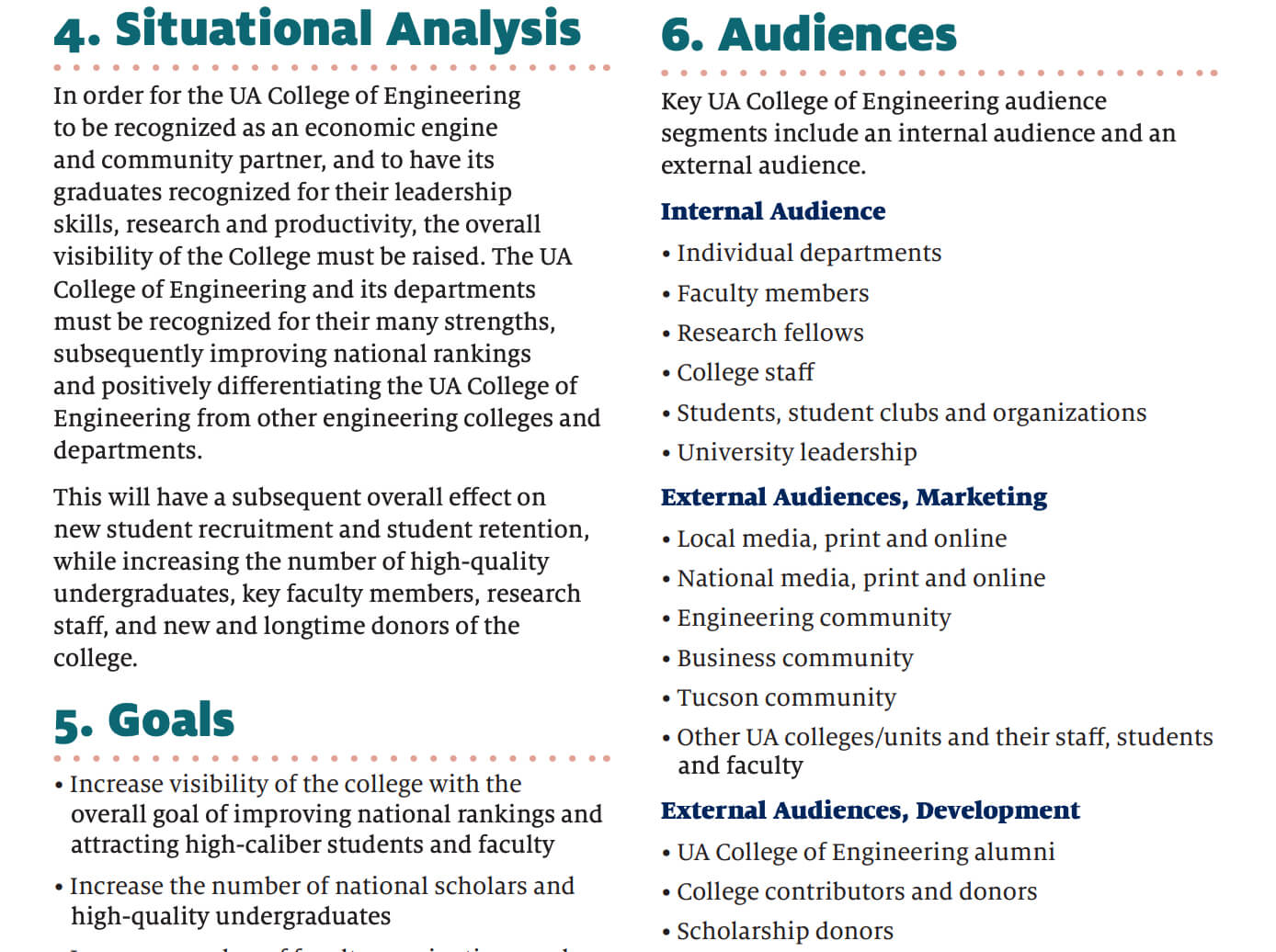
Timberland Regional Library This library's two-year marketing plan sets initiatives in motion with a clear schedule for action. It includes both promotional and production calendars for effective planning, which is especially important for campaigns pegged to external events. Dinsmore cites this plan’s “professional and elegant graphic design” as a strength. It also offers a roadmap for tackling several marketing campaigns on different timelines. However, he suggests that the plan needs more measurable goals and defined strategies. “There’s no overarching strategy that ties all of these tactics and initiatives together,” he says. “It’s just a laundry list of dates and actions.”
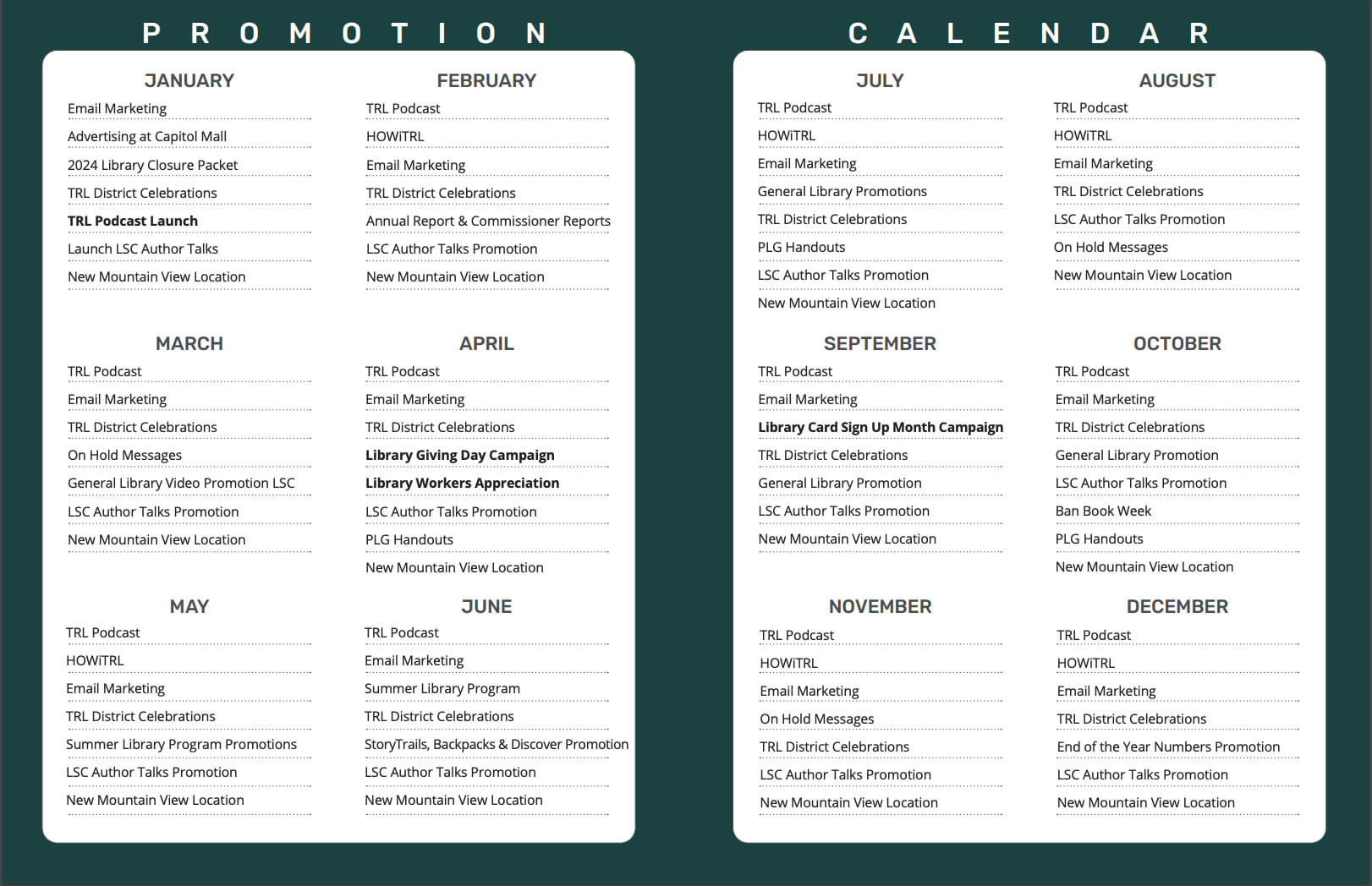
Safe Haven Family Shelter Nonprofit organizations need creative marketing strategies to reach their targets and use funds efficiently. With specific objectives and actionable steps, this marketing plan for Safe Haven Family Shelter delineates high-level goals and details the path to achieving them. It identifies the roles and responsibilities of individual team members to ensure alignment. Rarrick commends this plan for its “clearly defined audience and very clearly defined goals.” The plan showcases the differences between strategic business goals and measurable marketing objectives.
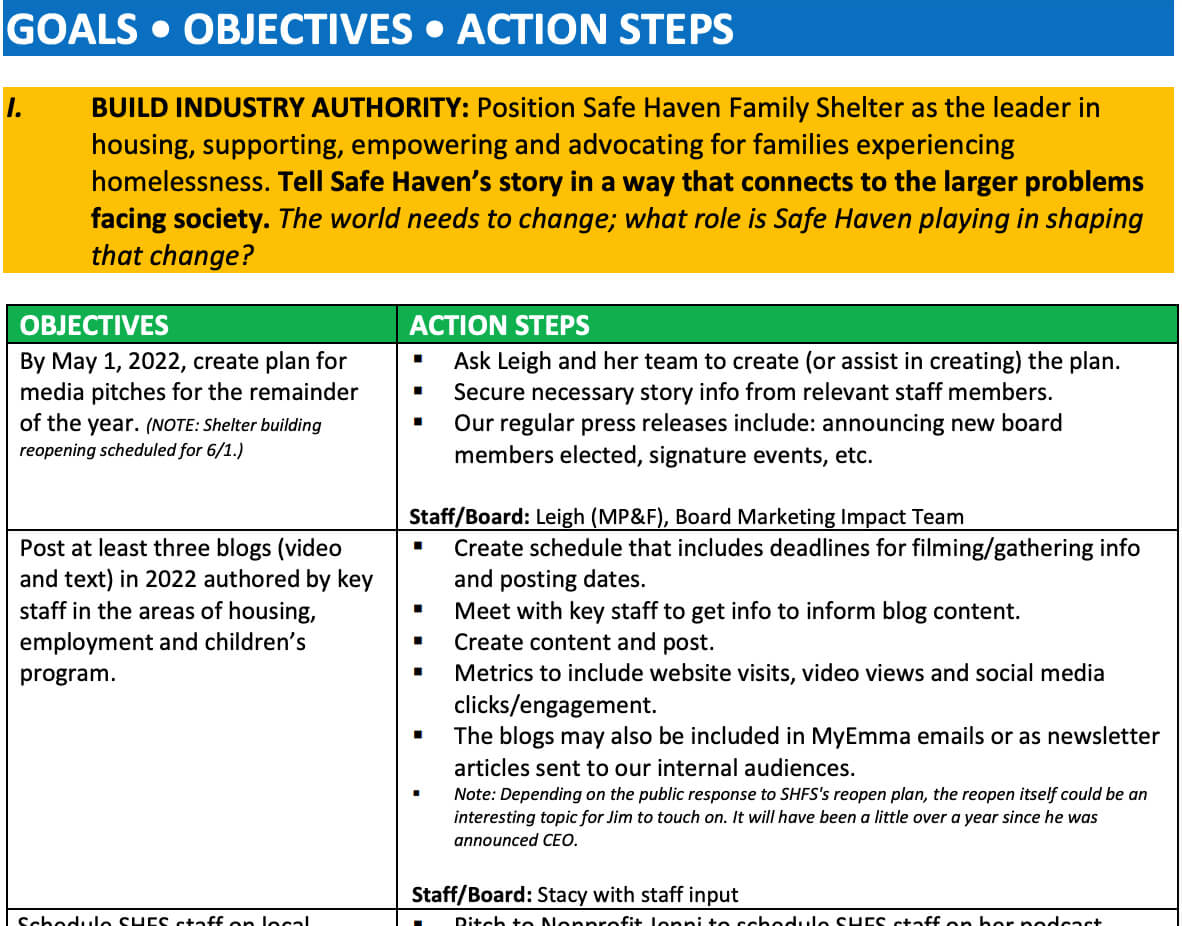
Visit Myrtle Beach This destination marketing plan by the Myrtle Beach, South Carolina Chamber of Commerce incorporates detailed information about target markets, audience personas, and key behaviors. It includes an infographic that illuminates the touchpoints in a traveler’s journey and shows the marketing team how each tactic contributes to conversions. Overall, Dinsmore praises this plan as a “very smart and thoughtful presentation.” It outlines a distinct media mix for each target audience, defines its objectives clearly, and ties these objectives to success metrics. He continues, “I want to thank the Myrtle Beach folks for planning to measure their efforts. Measurement is often anathema to marketing people, but if you’re not measuring, you don’t know how to improve.” With so much information to cover, the plan would benefit from an executive summary to introduce key takeaways. “The bigger the scope, the harder it is to make everything feel connected, and that’s a bit of an issue with this plan,” Dinsmore adds.
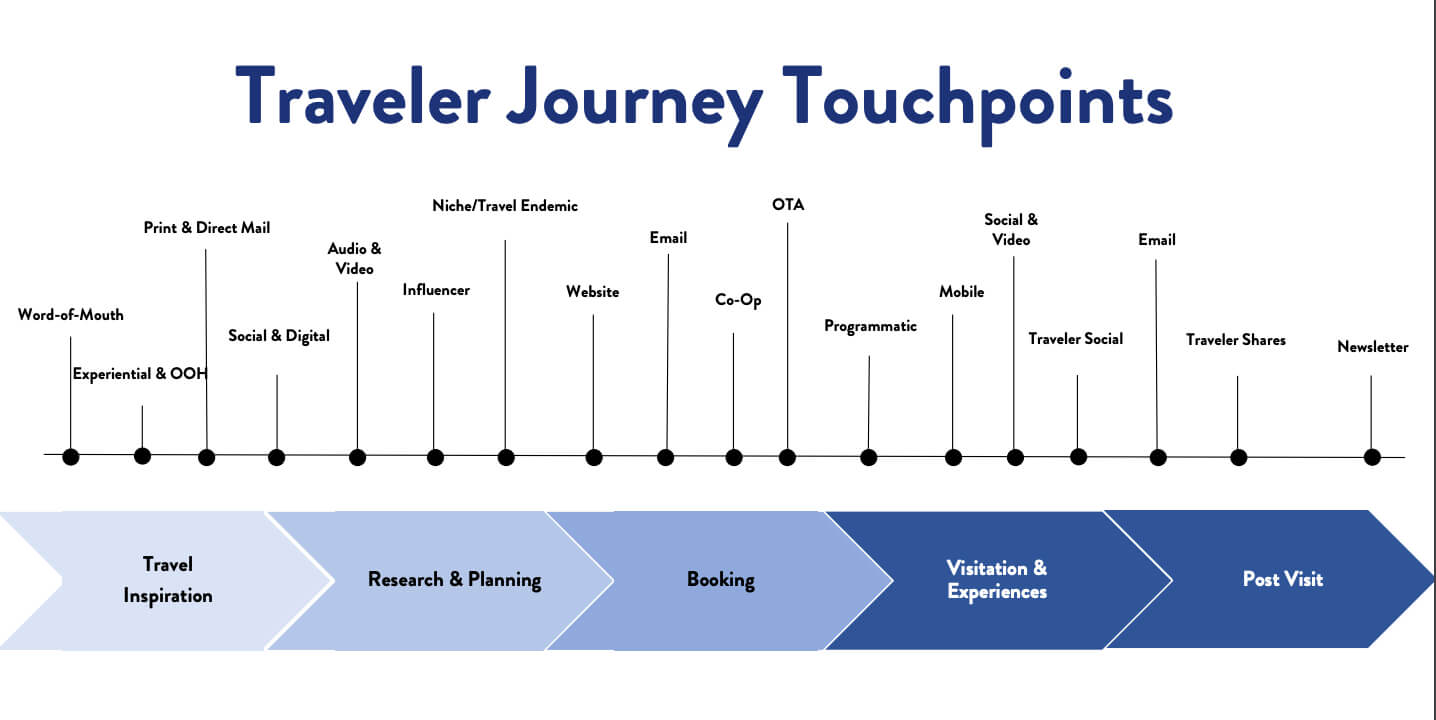
Tropical Avocados This example of a no-frills plan was commissioned by the nonprofit Improving Economies for Stronger Communities (IESC) to help brand and launch tropical avocados in the U.S. market. It shows the importance of making branding decisions backed by market and consumer research. A detailed SWOT analysis and competitive analysis provide essential insights that enable the company to determine the best unique selling proposition. A key strength of this plan is its detailed research into its audience. Fraser cites its “excellent identification of consumer objections — e.g., concern over how natural the avocado size is — and consumer behavior.” As a result, the brand can adopt effective messaging in its marketing campaigns. As with USDA Northeast Climate Hub’s Delmarva and the Ground for Change documentary, “target collaborators — e.g., food writers, organizations, and chefs — are included in the target audience. Collaborators are often more critical to the marketing plan than the consumers themselves,” Fraser adds.
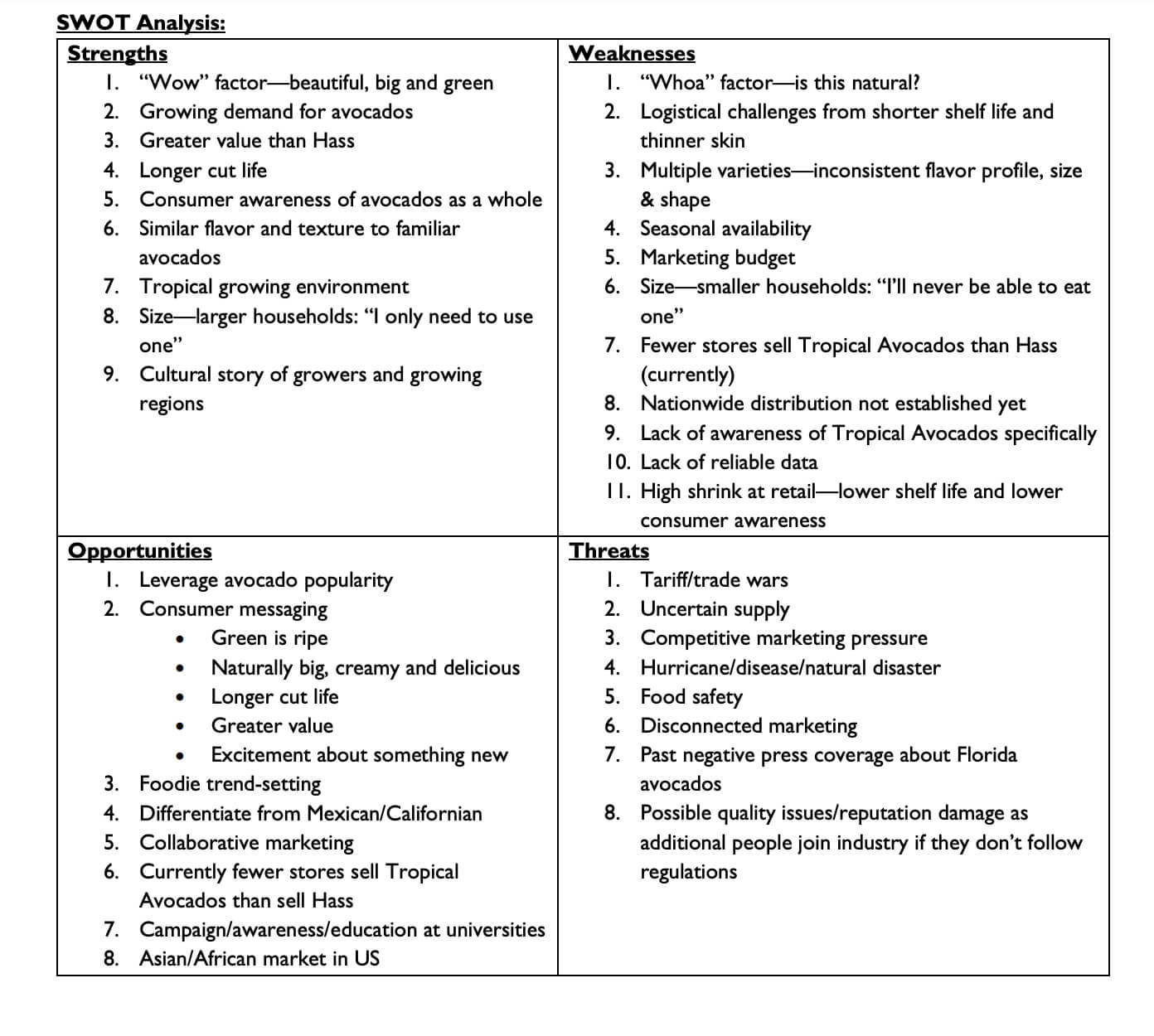
Rochelle Community Hospital This case study of Rochelle Community Hospital in Rochelle, Illinois, shows how a targeted marketing plan can be used to achieve significant results. The report by Legato Healthcare Marketing showcases the importance of reevaluating an existing marketing strategy — in this case, shifting the emphasis from print to digital. External marketing agencies often have more tools at their disposal, particularly if the business has not had a strong digital presence. With targeted ads and website updates, the agency employed tactics with direct metrics in order to track its impact.
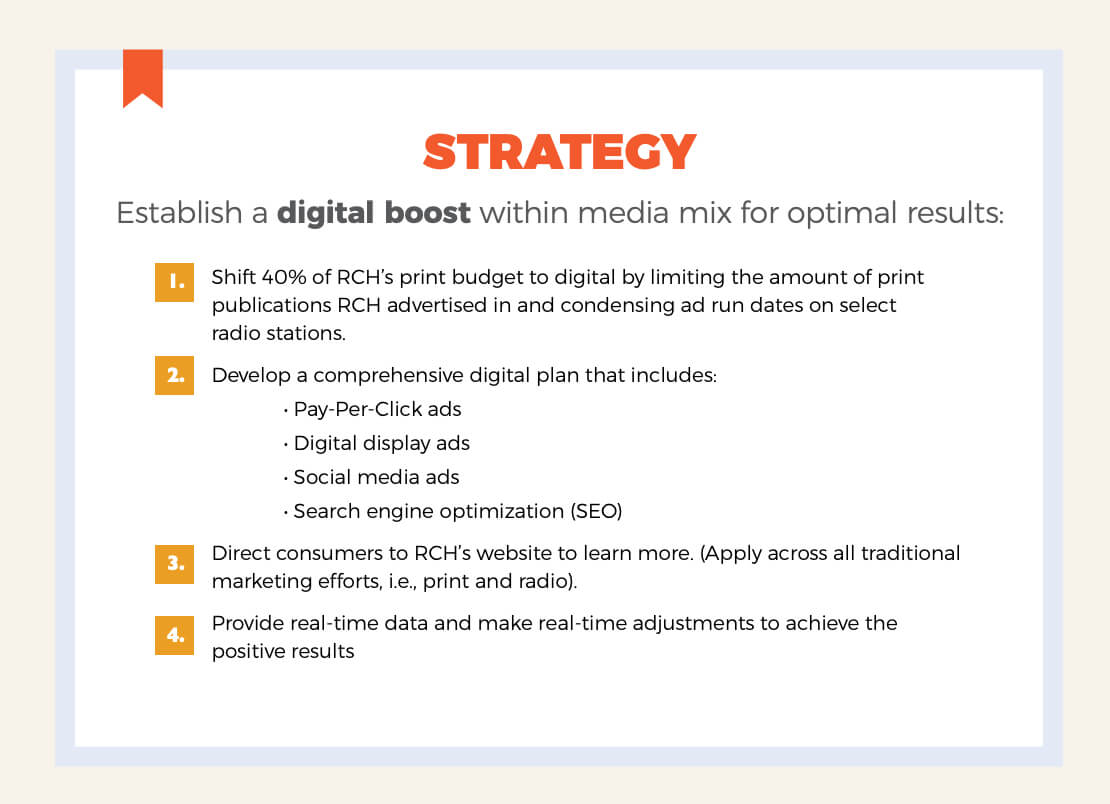
Visit Concord This example from the Concord Tourism Improvement District marketing plan is concise and includes streamlined insights on the audience and market. It details each marketing channel with specific tactics and measurable KPIs. The overall strategy, according to Fraser, offers “an excellent emphasis on social proof and word-of-mouth marketing,” as well as a “good balance of awareness and activation marketing.” In order to improve, he suggests, “the plan should factor in the following critical quantitative factors to help drive the media strategy: reach, frequency, and the total-addressable market.”
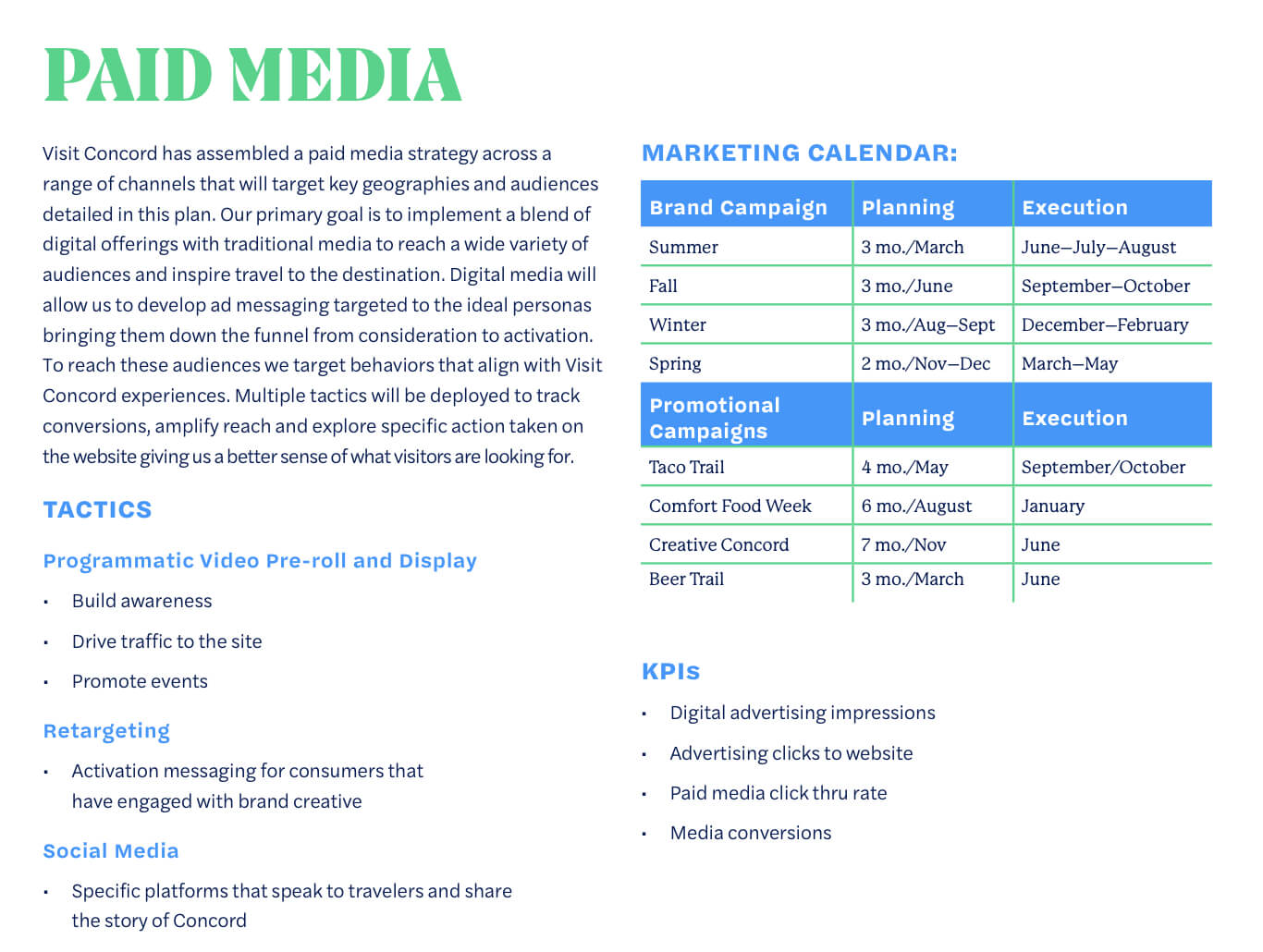
Marketing Plan Templates
Using a template takes the guesswork out of organizing a marketing plan document. These customizable templates include essential elements and options for specific industries or marketing channels, and they range from one-page plans to comprehensive, presentation-ready reports.
Microsoft Word Simple Marketing Plan Template
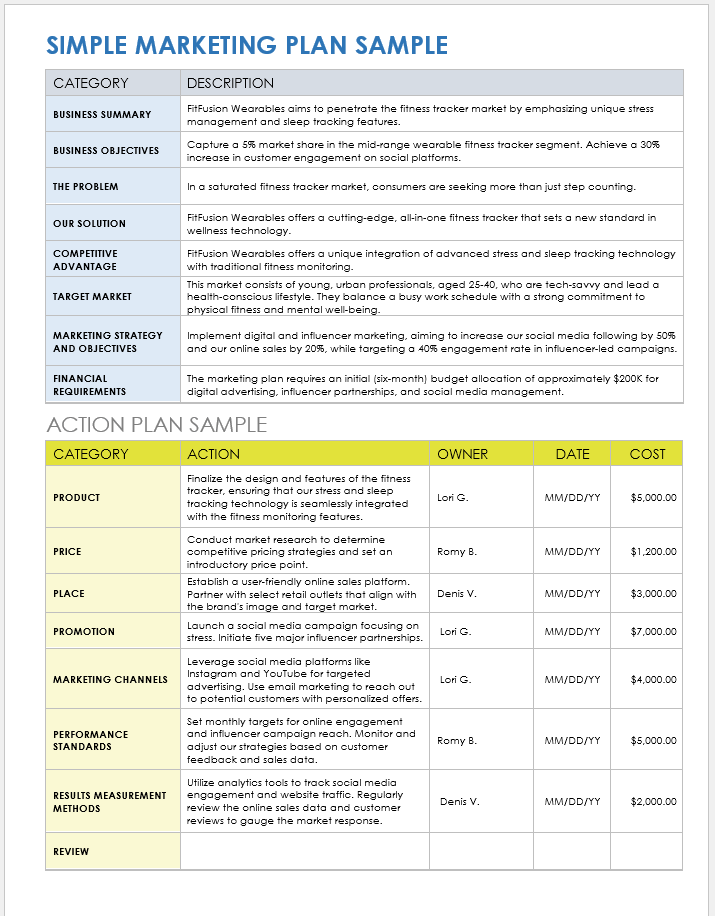
Download the Simple Marketing Plan Example Template for Microsoft Word Download the Blank Simple Marketing Plan Template for Microsoft Word
This example of a simple, customizable plan focuses on key strategies and prioritizes readability. This one-page marketing plan template includes space to summarize marketing strategy and overarching business objectives, along with an action plan to highlight responsibilities and deadlines.
Microsoft Word Annual Marketing Plan Template
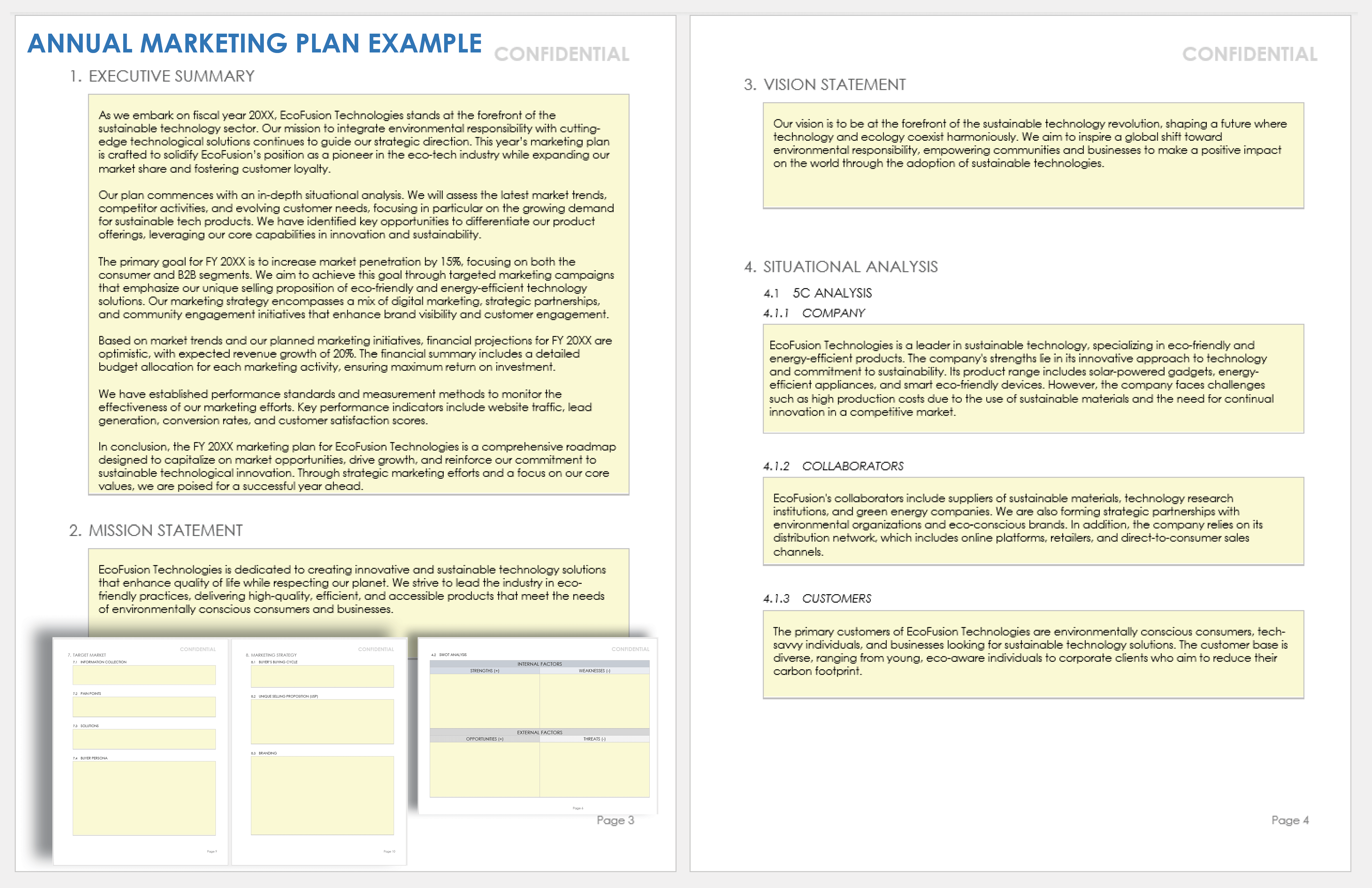
Download the Annual Marketing Plan Example Template for Microsoft Word Download the Blank Annual Marketing Plan Template for Microsoft Word
This comprehensive marketing plan template includes a number of key sections — such as goals, target market, marketing channels, and performance standards — that can be customized to suit a variety of businesses. In the situational analysis, you can find space for both a 5C (company, collaborators, customers, competitors, climate) analysis and a SWOT analysis. The blank template begins with a table of contents, a business summary, and a mission statement to allow for easy readability. The sample focuses on marketing strategies for one fiscal year, but you can modify this plan for any time period.
Microsoft Word Small Business Marketing Plan Template
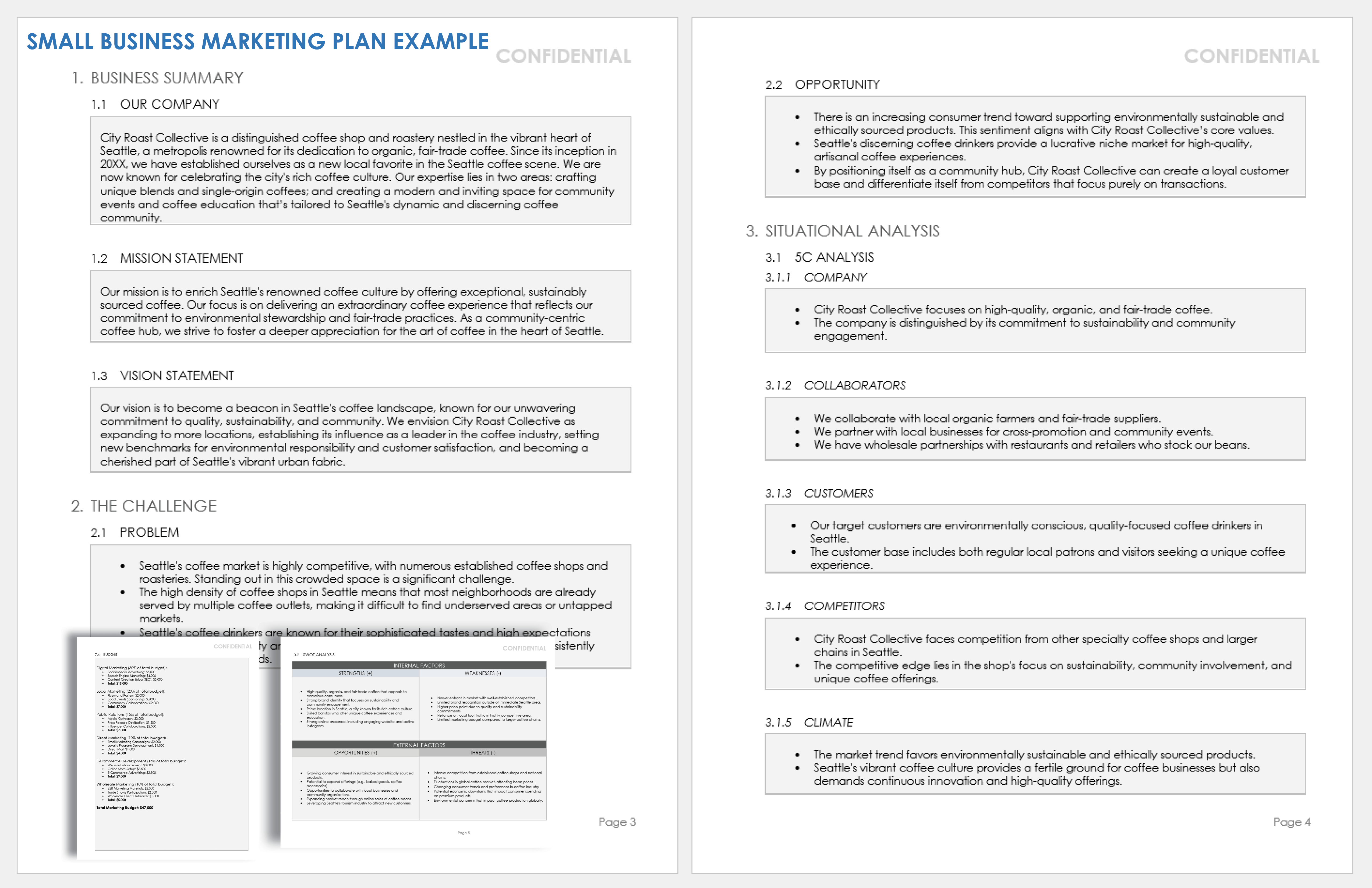
Download the Small Business Marketing Plan Example Template for Microsoft Word Download the Blank Small Business Marketing Plan Template for Microsoft Word
A strong marketing plan is essential for small businesses looking to stand out from larger competitors. This small business marketing plan template provides an outline for a detailed marketing strategy, including a unique selling proposition, the 4Ps marketing mix, and marketing channels. It builds its strategy on situational analysis and identification of the business’s core capabilities. Find more marketing plan templates for different industries.
Microsoft Word Nonprofit Marketing Plan Template
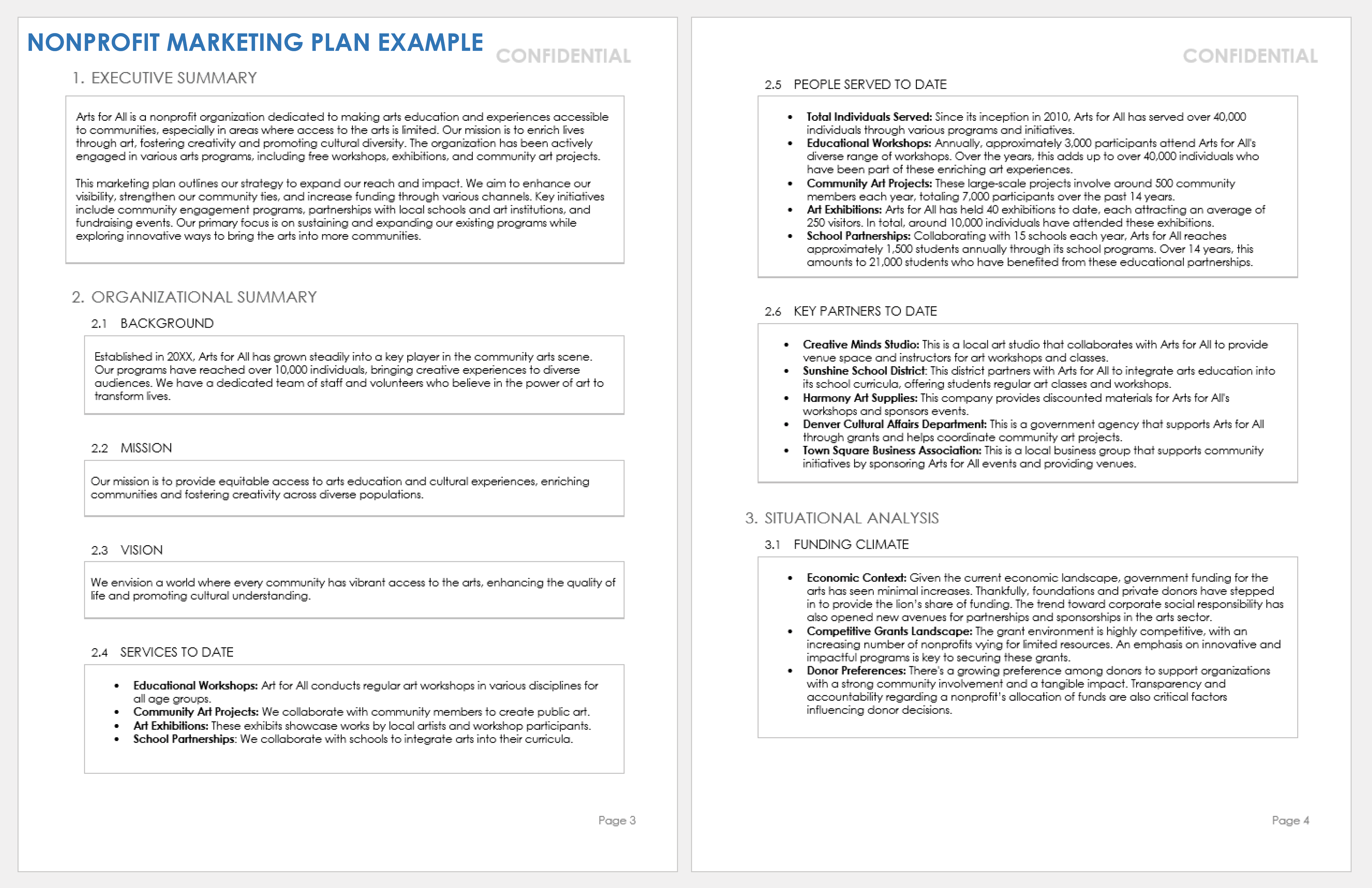
Download the Nonprofit Marketing Plan Example Template for Microsoft Word Download the Blank Nonprofit Marketing Plan Template for Microsoft Word
This example marketing plan for a nonprofit incorporates information on the funding climate into its situational analysis, as well as a detailed organizational summary. With sections for short- and long-term goals, marketing strategies and channels, and stakeholder profiles, the template is comprehensive and customizable. Find more nonprofit marketing plan templates here .
Excel Product Marketing Plan Template
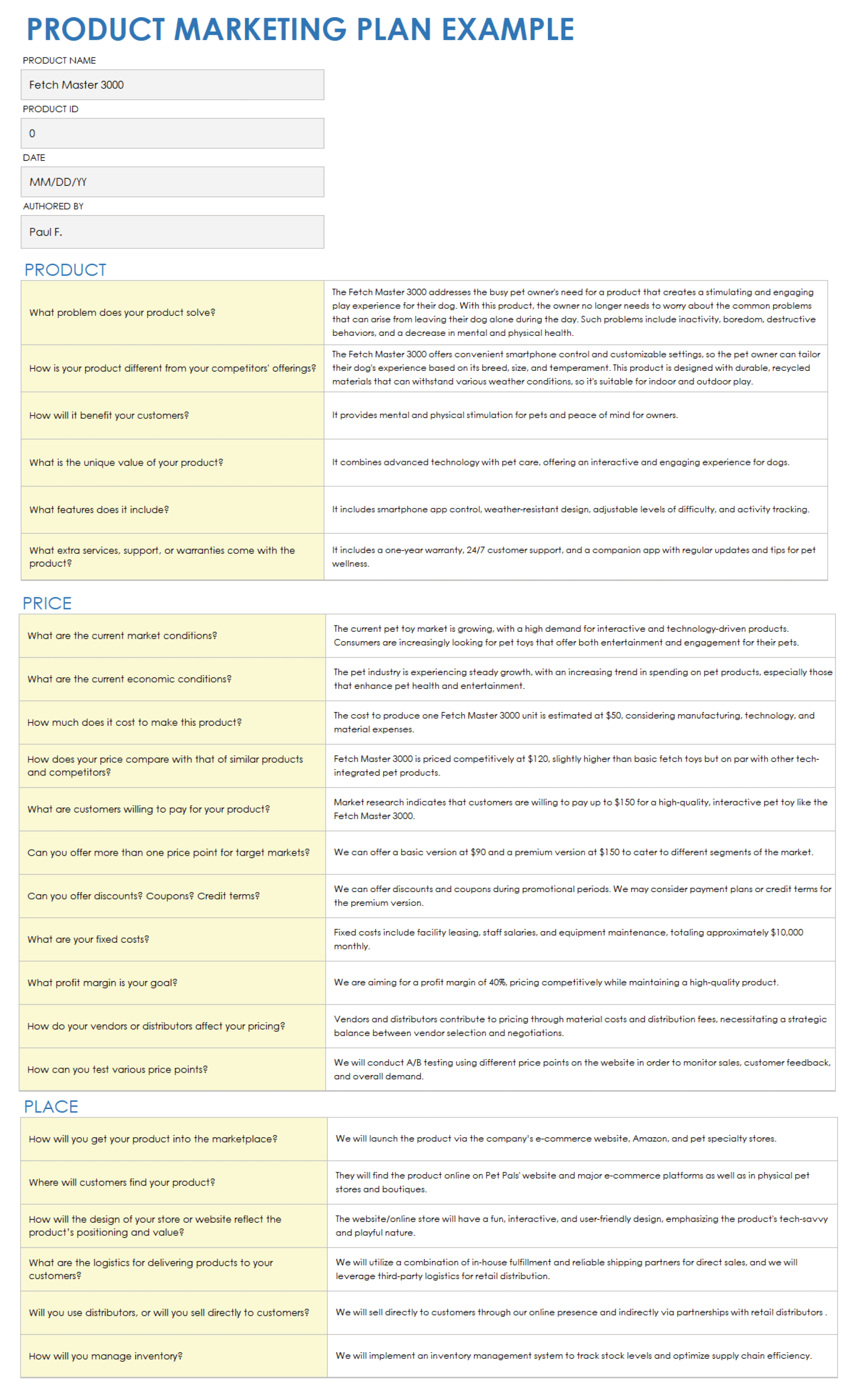
Download the Product Marketing Plan Example Template for Excel Download the Blank Product Marketing Plan Template for Excel
When integrating a new product into existing marketing strategies, it’s important to take into account all the elements of the marketing mix. This product marketing plan template is organized by product, price, place, promotion, process, people, and physical evidence. In these sections, you can find space to consider market research, consumer behaviors, and marketing channels.
Excel Social Media Marketing Plan Template
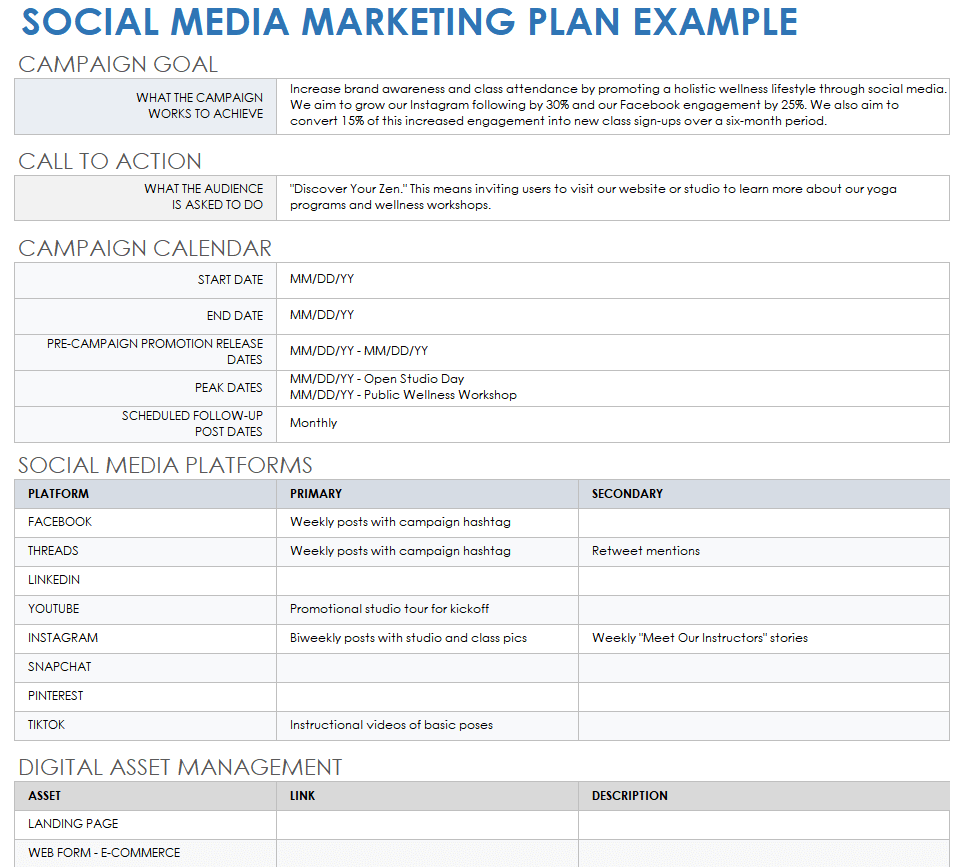
Download the Social Media Marketing Plan Example Template for Excel Download the Blank Social Media Marketing Plan Template for Excel
For planning specific campaigns, this social media marketing action plan template begins with the campaign goal, highlights important promo dates, and separates actions by platform. It’s useful for executing targeted social media campaigns within a larger marketing strategy. Find more marketing action plan templates here .
Excel Digital Marketing Plan Template
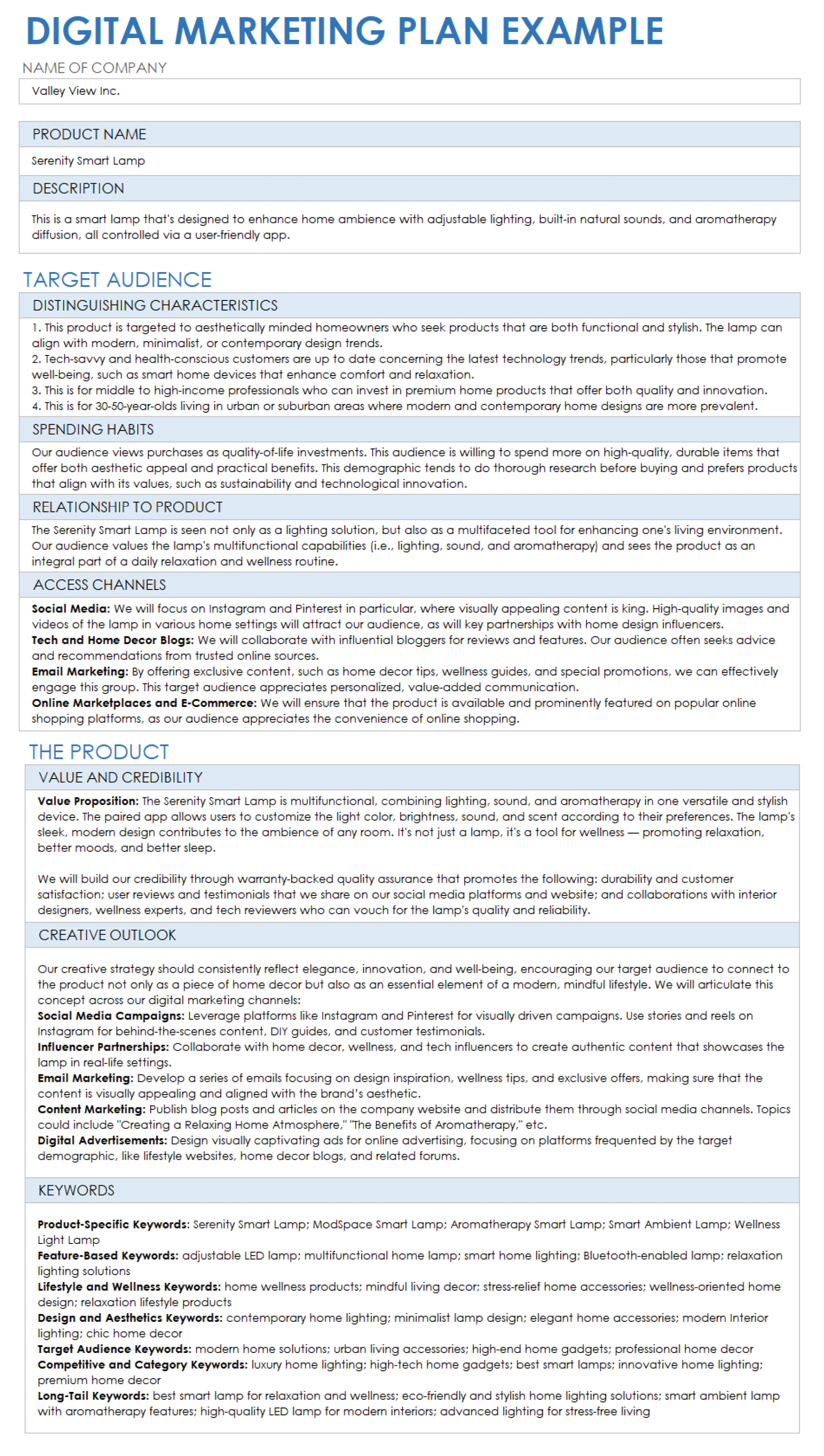
Download the Digital Marketing Plan Example Template for Excel Download the Blank Digital Marketing Plan Template for Excel
Focusing on digital marketing channels is an effective way to organize strategies into a streamlined and actionable plan. This strategic digital marketing template highlights important audience behaviors and access channels to ensure messaging reaches consumers. Customizable for a variety of digital marketing projects, the template includes space for keywords, goals, and tasks. Find more digital marketing plan templates here .
Which Marketing Plan Format Is Right for You?
To choose the right marketing plan format for your needs, consider the plan’s role in your marketing strategy. Do you need a comprehensive plan to provide an overview of tactics that will take place over a long period of time? Or are you looking for a plan to focus on specific channels, campaigns, or product launches?
Each template in this article offers space to detail market research, strategies, and access channels. The longer plans include more sections for in-depth situational analysis and audience demographics, while the shorter plans focus on the marketing mix and action plan. This chart highlights the key elements of each marketing plan:
Streamline Your Marketing Plan Efforts with Smartsheet
The best marketing teams know the importance of effective campaign management, consistent creative operations, and powerful event logistics -- and Smartsheet helps you deliver on all three so you can be more effective and achieve more.
The Smartsheet platform makes it easy to plan, capture, manage, and report on work from anywhere, helping your team be more effective and get more done. Report on key metrics and get real-time visibility into work as it happens with roll-up reports, dashboards, and automated workflows built to keep your team connected and informed.
When teams have clarity into the work getting done, there’s no telling how much more they can accomplish in the same amount of time. Try Smartsheet for free, today.
Improve your marketing efforts and deliver best-in-class campaigns.

IMAGES
COMMENTS
Jul 26, 2024 · Learn what a marketing strategy is, how it works, and how to create one for your business. A marketing strategy is a business’s plan to convince customers to buy its products or services,...
Oct 10, 2024 · Learn the difference between marketing strategy and marketing plan, and how to create them for your business. This guide covers the essential components, process, and examples of a complete marketing strategy in 2025.
Jul 19, 2019 · Learn how to write the marketing strategy section of a business plan using the four P's: product, place, price, and promotion. See an example layout and tips for each P.
Sep 13, 2022 · Let's focus on some marketing strategy examples for your business plan. A solid marketing strategy addresses the four Ps: product, promotion, price, and place. Your success can depend on understanding your clients’ needs and being flexible enough to find a way to meet them.
Aug 7, 2024 · A marketing plan is a strategic road map that outlines marketing objectives, strategies, and tactics for a business. Learn the differences between marketing plan, strategy, and business plan, and see examples of marketing plans for various industries and goals.
Nov 25, 2024 · A marketing strategy is an overview of how a business or organization will articulate its value proposition to its customers. Generally, a marketing strategy outlines business goals, target market, buyer personas, competitors, and value for customers. It provides a long-term vision for overall marketing efforts, often looking many years ahead.
Mar 28, 2024 · Learn how to create a marketing plan with a step-by-step guide and free templates. Find out how to identify your target customers, conduct a SWOT and market analysis, set SMART goals, and more.
Jan 3, 2024 · Describe how you plan to reach and sell to your potential customers, what your sales strategy will be, and what marketing activities you will use to make your business successful.
Jul 2, 2024 · A marketing plan is an operational document that outlines an advertising strategy to reach your target market. Learn the components, types, and steps of a marketing plan and why it is...
Apr 27, 2024 · Learn how to create a comprehensive marketing plan with nine elements, 10 real-world examples, and free templates. Find out how to analyze your market, define your goals, and execute your strategy.